Updated: 26 January 2024 by Sylwia (MyCrochetory)
Learn how to crochet a stunning and colorful mosaic crochet cowl with the Namari Mosaic Crochet Cowl Pattern. This free crochet cowl pattern is perfect for fall, combining texture, modern style, and vibrant colors.
Scroll down to see the Namari Mosaic Cowl free crochet pattern or you may choose to purchase the ad-free, printable PDF crochet pattern HERE on ETSY or HERE on Ravelry.
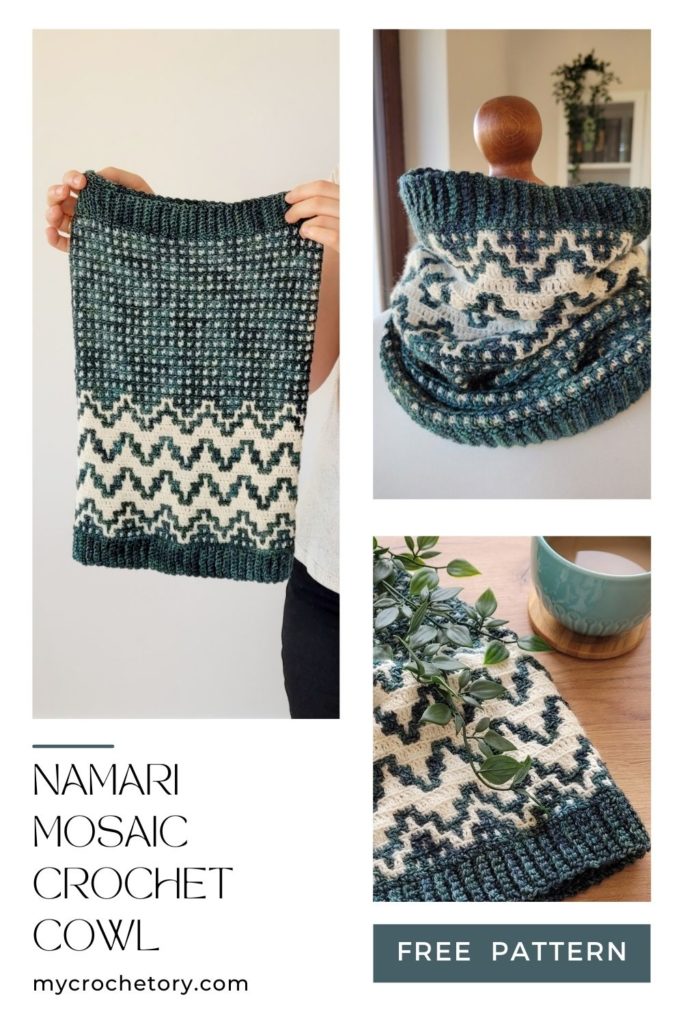
Join my Facebook Group and Official Ravelry Group where you can find necessary support, you can ask questions or share your finished projects.
You can also follow my Instagram, Facebook page and Pinterest.

Introducing the Namari Mosaic Crochet Cowl Pattern
Imagine wrapping yourself in a cozy and eye-catching accessory that reflects your personal style.
The Namari Mosaic Crochet Cowl pattern is the perfect companion for fall, adding a touch of warmth and sophistication to any outfit.
I was inspired to create a cowl that combines texture, vibrant colors, and a modern twist.
The Namari Cowl is not only a practical accessory but also an expression of creativity and self-expression.

A Fascinating Colorwork Technique
Mosaic crochet is like painting with yarn, where contrasting colors come together to form intricate patterns. It’s a technique that never fails to mesmerize and fascinate.
With the Namari Mosaic Crochet Cowl pattern, I wanted to showcase the versatility of this method and make it accessible to all crocheters.
The pattern features an easy-to-master mosaic crochet pattern, allowing you to create stunning colorwork without the complexity.

Creating Your Namari Mosaic Cowl
Let’s begin a delightful crochet journey as we bring the Namari Mosaic Cowl to life.
From selecting the perfect fingering weight yarn to choosing contrasting colors that harmonize beautifully, each step is an opportunity to infuse your personal touch into the project.
I’ll guide you through the pattern with clear instructions and helpful tips, ensuring your experience is both enjoyable and rewarding.
Along the way, you’ll witness the magic of watching the mosaic pattern emerge row by row.

Customizing Your Mosaic Crochet Cowl
The Namari Mosaic Crochet Cowl pattern offers versatility in both size and yarn choice.
Whether you prefer a snug fit or a more relaxed drape, you can easily adjust the pattern to match your preferences.
As for the yarn, this pattern is perfect for utilizing those half skeins of fingering weight yarn that often accumulate in our stash.
Experience the freedom to mix and match colors, creating a unique mosaic crochet cowl pattern that truly reflects your style.
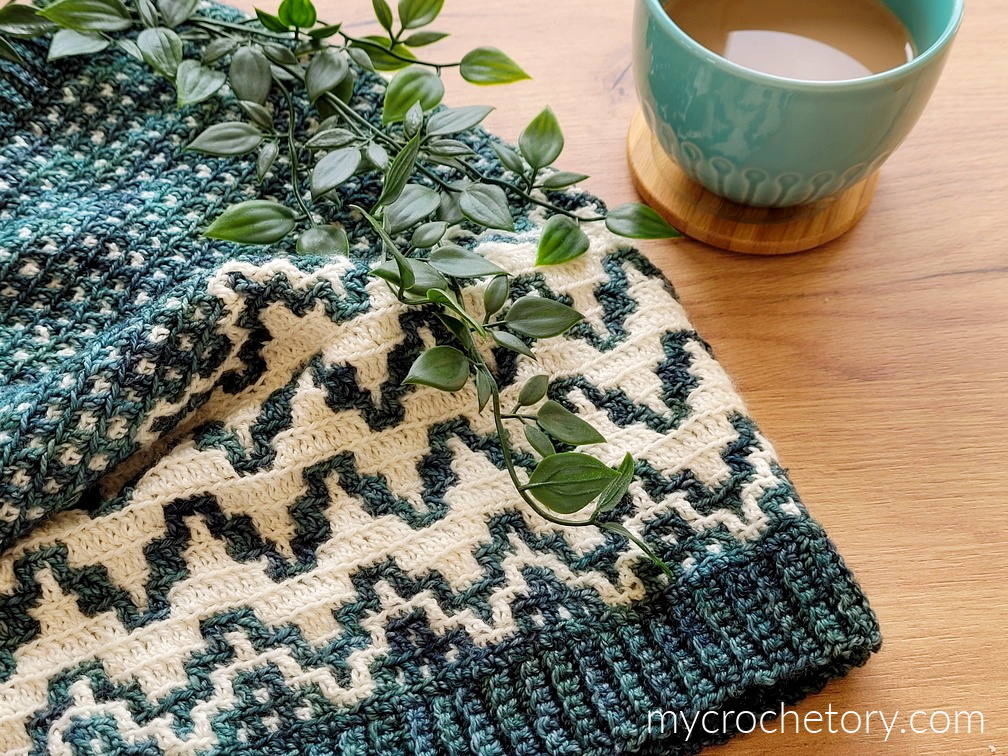
Frequently Asked Questions
Q1: Can I make the cowl larger or smaller?
A1: Absolutely! The Namari Mosaic Cowl pattern provides instructions on adjusting the size to suit your needs, making it a versatile project for crocheters of all skill levels.
Q2: Is mosaic crochet difficult for beginners?
A2: Not at all! The mosaic crochet technique may seem intricate, but with detailed instructions and the easy-to-master pattern, beginners can confidently explore the world of colorwork and create a stunning cowl.
Q3: Can I sell the cowls I make using this pattern?
A3: Yes, you’re welcome to sell the finished Namari Mosaic Cowls. Spread the joy of mosaic crochet by sharing your handmade creations with friends, family, and even at craft fairs.
Now, get your crochet hooks ready and let your creativity soar as you crochet the Namari Mosaic Cowl.
With its vibrant colors and captivating pattern, this crochet cowl is sure to become a cherished accessory for fall and beyond.
OTHER FREE CROCHET COWL PATTERNS YOU MIGHT LOVE
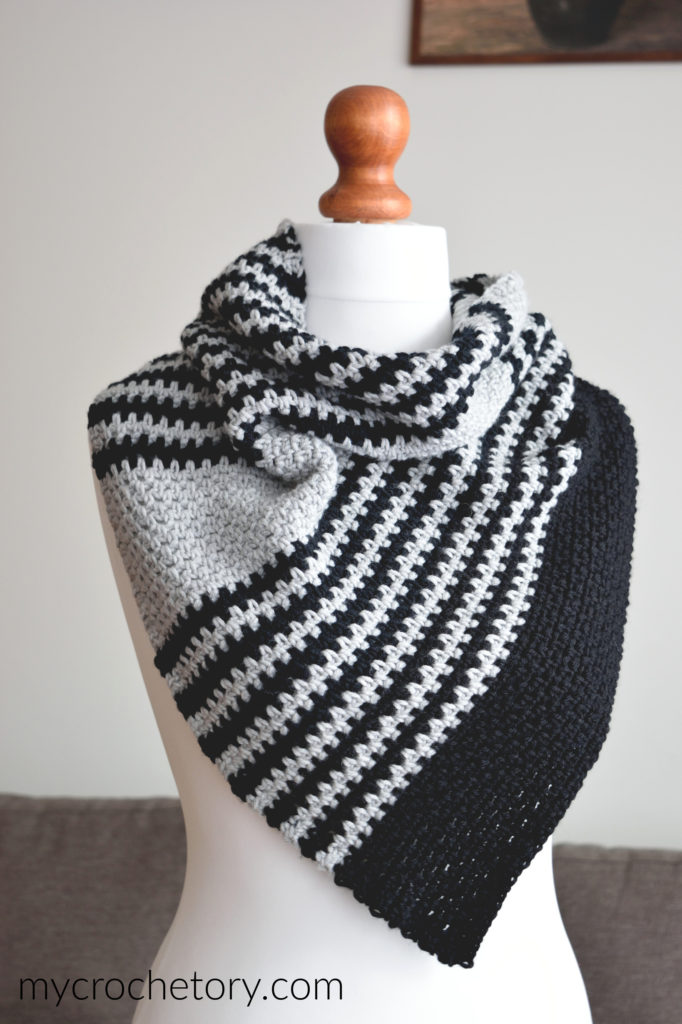

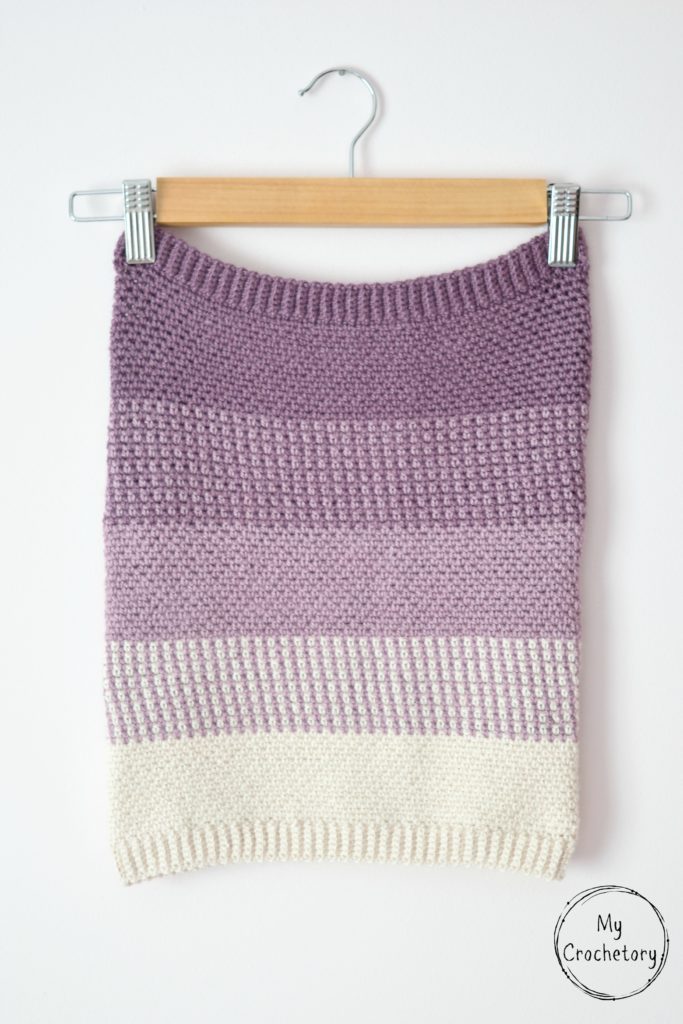
If you want to share your wips and finished mosaic crochet cowl on social media, please, use hashtag #mycrochetory. I love to see your finished cowls!
NAMARI MOSAIC CROCHET COWL FREE PATTERN
- Purchase the ad-free, printable PDF here on ETSY or here on Ravelry.
- Add this pattern to your Ravelry Queue HERE.
- Pin it for later.
Copyright 2021 – 2024 MyCrochetory. All right reserved. This pattern is property of Sylwia Kawczyńska @MyCrochetory. Please DO NOT sell the pattern and claim this pattern as your own. The pattern is for personal use only and may not be translated or reproduced in another language. Please respect my rights, DO NOT share or publish this pattern anywhere without my permission.
The mosaic crochet cowl you make following this pattern is yours you are free to sell it, as long as you credit MyCrochetory as original designer. For more information, please, read Terms Page.
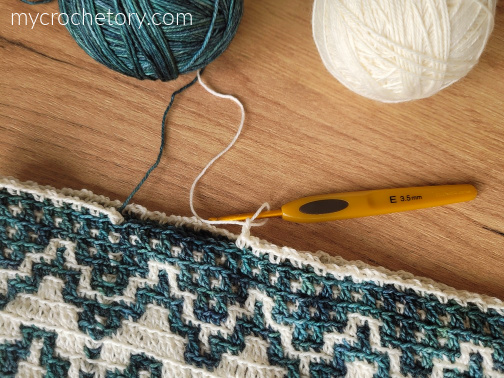
Materials & Tools:
- Yarn Malabrigo Sock Yarn 100g = 400m, 100% Merino Wool, in 2 colors:
Yarn A: Aquas – 312m,
Yarn B: Natural – 156m.
- Hook size 3.5mm. Adjust hook size if necessary to obtain correct gauge,
- Tapestry needle (to weave and hide yarn ends),
- Scissors,
- Stitch marker.
Level:
Intermediate – mosaic crochet.
Sizes:
One size, adjustable: approx. 57 cm/22.5” circumference and 42 cm/16.5” high.
Gauge after blocking:
21 sts and 20 rows = 10 cm x 10 cm using sc.
If necessary, adjust hook size to obtain the correct gauge.
Before you measure, please take the time to block your swatch in the same manner that you will block your cowl.
General Notes:
- The cowl, after the ribbing, is worked in rounds.
- Pattern for mosaic body is multiple of 10 stitches. To increase the circumference of the cowl, increase the number of rows in ribbing. To decrease the circumference of the cowl, decrease the number of rows in ribbing.
- To increase the height of the cowl, increase the repeats of rows 36 – 37. To decrease the height of the cowl, decrease the repeats of rows 36 – 37.
- STITCHES: When in the instructions you have a stitch followed by a number, eg sc14, this means you have to work 1sc stitch into each of the next 14 sts. When in the instructions you have a number followed by a stitch, eg 2sc, this this means you have to work 2 sc stitches into the next (same) stitch.
- Instructions in square brackets […] are worked as many times as indicated.
Mosaic Pattern Notes:
- You can either follow the chart or written instructions.
- Color is changed after every one round.
- You can avoid weaving in all those ends by not cutting the yarn when you finish a round. Simply carry the other color along the inside and pick it back up with your hook when you need to use it again.
How to read the Mosaic Chart:
- Chart is read from bottom to top and each row of squares represents 1 round.
- All rounds are read from right to left.
- Each square of the chart represents 1 stitch or 1 skipped stitch.
- Whenever you see a square of color dedicated to that round, work single crochet.
- Whenever you see a square of different color in that round, skip that stitch (make chain). To prevent puckering, make the same number of chain as the number of skipped sts plus ch1. For example, for 1 skipped st – make ch2, for 2 skipped sts – make ch3, for 3 skipped sts – make ch4, etc.
- Pay special attention to number of skipped stitches.
- BLmosaicdc will be worked in these skipped sts from two rounds below. Remember, BLmosaicdc are always worked in front of chains of previous round.
Stitches & Abbreviations (US terms):
st(s) – stitch(es)
BLsc – back loop only single crochet
BLdc – back loop only double crochet
yo – yarn over
BLmosaicdc (back loop only mosaic double crochet) – work regular BLdc in unworked/skipped st of the same color two rounds below in front of chain space (in front of work). These chains will stay behind BLmosaicdc and will stay unworked.
M – marker
PM – place marker
BOR – beginning of the row/round
sp – space
sk – skip
beg – beginning
prev – previous
PATTERN
Read all Notes before you start.
Ribbing 1
With 3.5 mm hook and Yarn A work ch9.
Row 1: sc in second ch from hook, sc in each ch to end. Turn.
Row 2: ch1 (doesn’t count as a sc), BLsc across to end. Turn.
You should have 8 stitches in each row.
Repeat Row 2 118 more times for a total of 120 rows or until desired length.
After your last repeat of row 2 join the first and the last row together.
Remember, this pattern is a multiple of 10 stitches, so in your Ribbing 1 section you should have multiple of 10 rows.
Don’t break the yarn.


Main Body

In the following Round 1 every stitch will be working in each ribbing’s row.
Round 1 (yarn A): ch1 (doesn’t count as a st), sc in first ribbing’s row, place BOR marker, sc in each ribbing’s rows until BOR, slst to BOR to join. Change to Yarn B in final st.



Round 2 (yarn B): ch1, sc1 in BOR (mark this st as a new BOR), BLsc1, ch2, sk 1st, BLsc1, ch2, sk 1st, BLsc1, ch2, sk 1st, BLsc1, ch2, sk 1st, BLsc1, [BLsc2, ch2, sk 1st, BLsc1, ch2, sk 1st, BLsc1, ch2, sk 1st, BLsc1, ch2, sk 1st, BLsc1] rep around until BOR, slst to BOR to join. Change to Yarn A in final st.



Round 3 (yarn A): ch1, sc1 in BOR (mark this st as a new BOR), ch2, sk 1st, BLmosaicdc1, BLsc1, BLmosaicdc1, BLsc1, BLmosaicdc1, BLsc1, BLmosaicdc1, ch2, sk 1st, [BLsc1, ch2, sk 1st, BLmosaicdc1, BLsc1, BLmosaicdc1, BLsc1, BLmosaicdc1, BLsc1, BLmosaicdc1, ch2, sk 1st] rep around until BOR, slst to BOR to join. Change to Yarn B in final st.





Round 4 (yarn B): ch1, sc1 in BOR (mark this st as a new BOR), BLmosaicdc1, BLsc2, ch2, sk 1st, BLsc1, ch2, sk 1st, BLsc2, BLmosaicdc1, [ch2, sk 1st, BLmosaicdc1, BLsc2, ch2, sk 1st, BLsc1, ch2, sk 1st, BLsc2, BLmosaicdc1] rep around until BOR, slst to BOR to join. Change to Yarn A in final st.



Round 5 (yarn A): ch1, sc1 in BOR (mark this st as a new BOR), BLsc2, ch2, sk 1st, BLmosaicdc1, BLsc1, BLmosaicdc1, ch2, sk 1st, BLsc2, [BLmosaicdc1, BLsc2, ch2, sk 1st, BLmosaicdc1, BLsc1, BLmosaicdc1, ch2, sk 1st, BLsc2] rep around until BOR, slst to BOR to join. Change to Yarn B in final st.
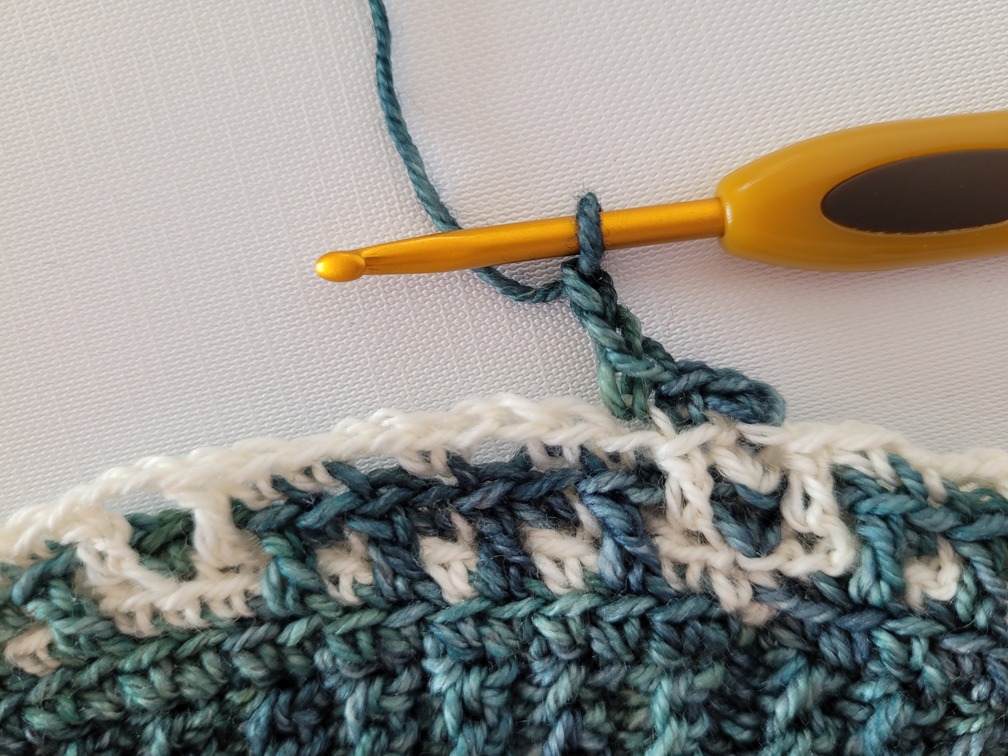

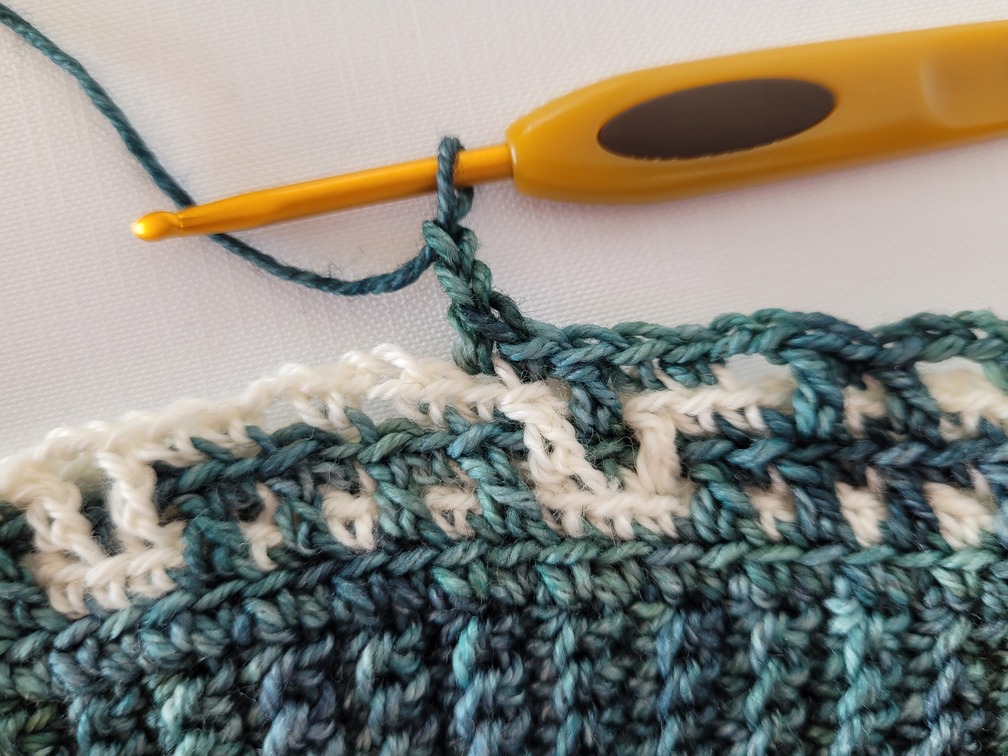
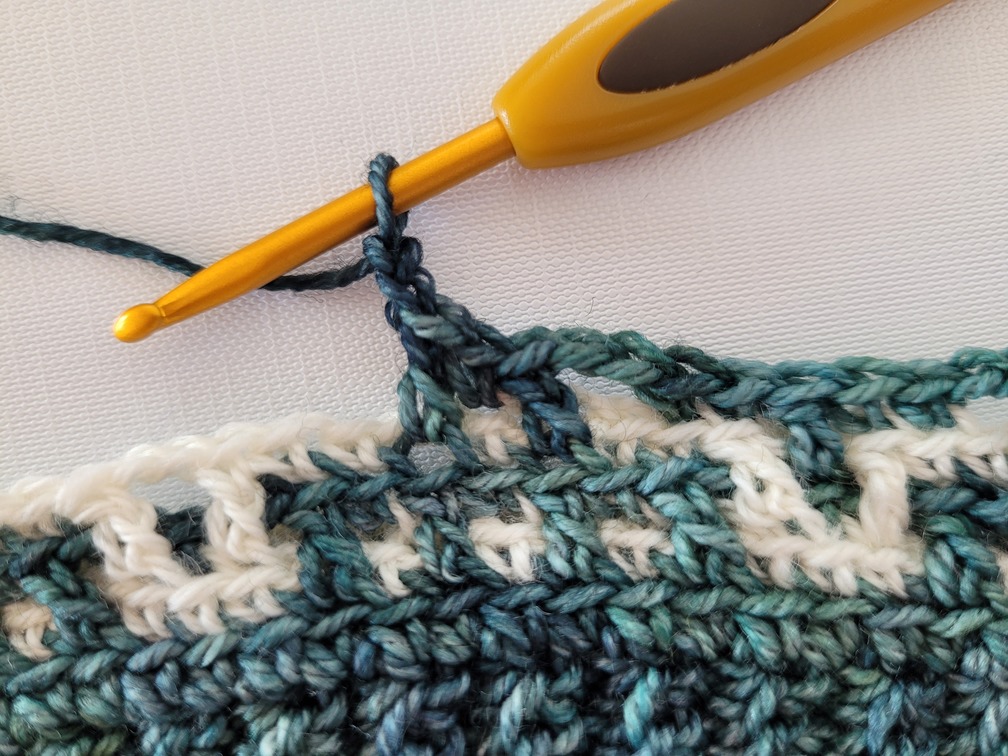
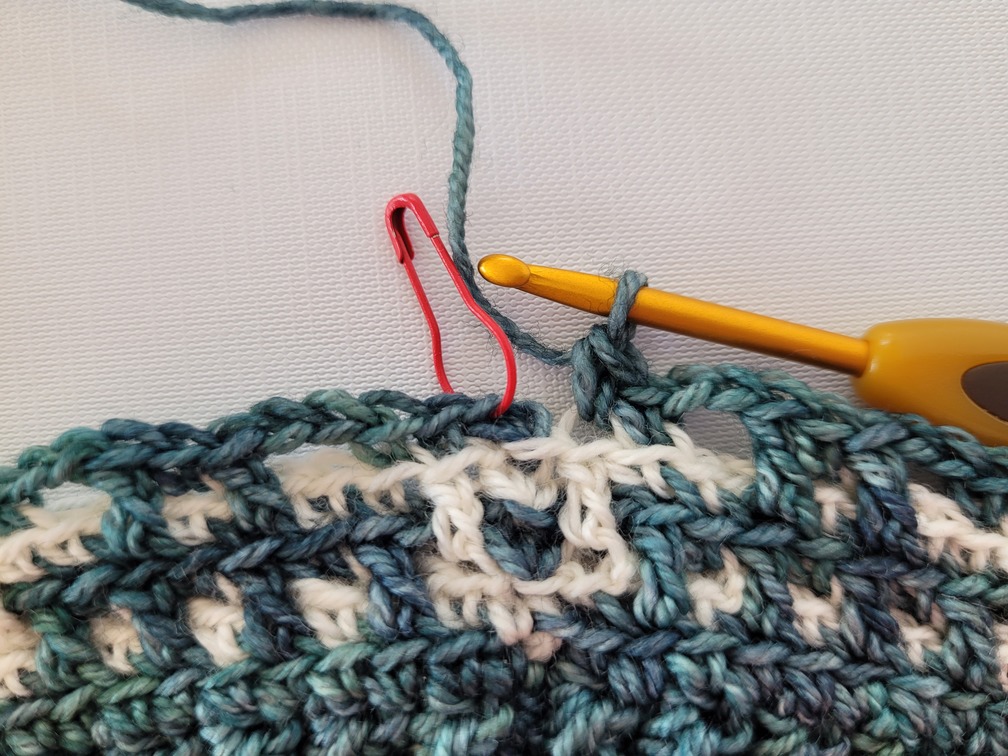
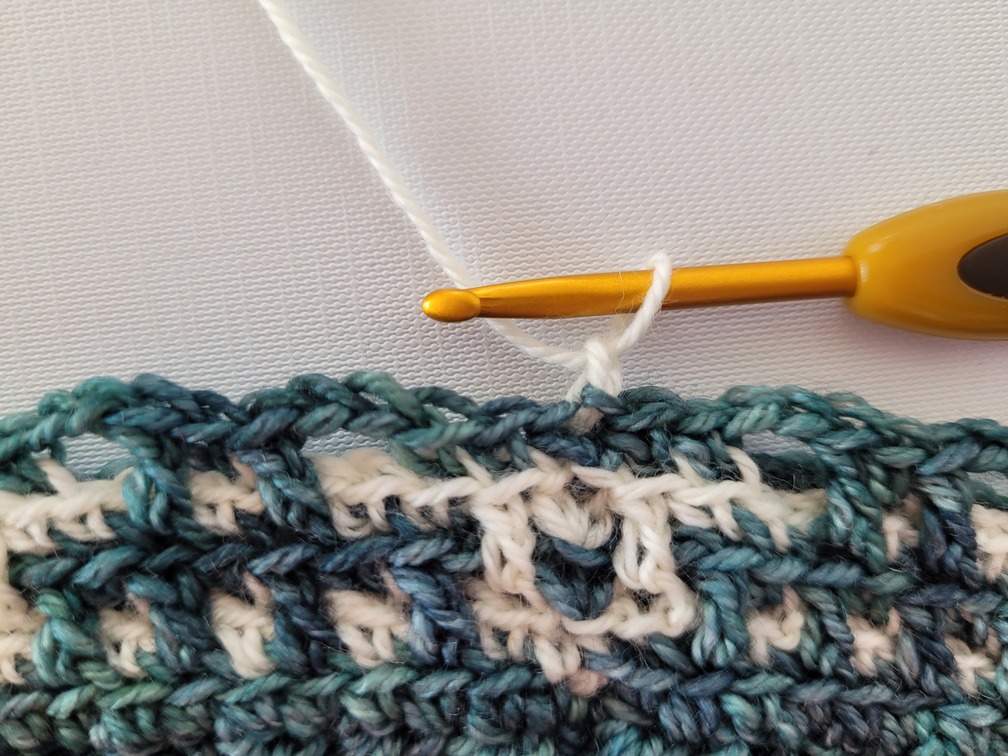
Round 6 (yarn B): ch1, sc1 in BOR (mark this st as a new BOR), BLsc1, ch2, sk 1st, BLmosaicdc1, BLsc3, BLmosaicdc1, ch2, sk 1st, BLsc1, [BLsc2, ch2, sk 1st, BLmosaicdc1, BLsc3, BLmosaicdc1, ch2, sk 1st, BLsc1] rep around until BOR, slst to BOR to join. Change to Yarn A in final st.

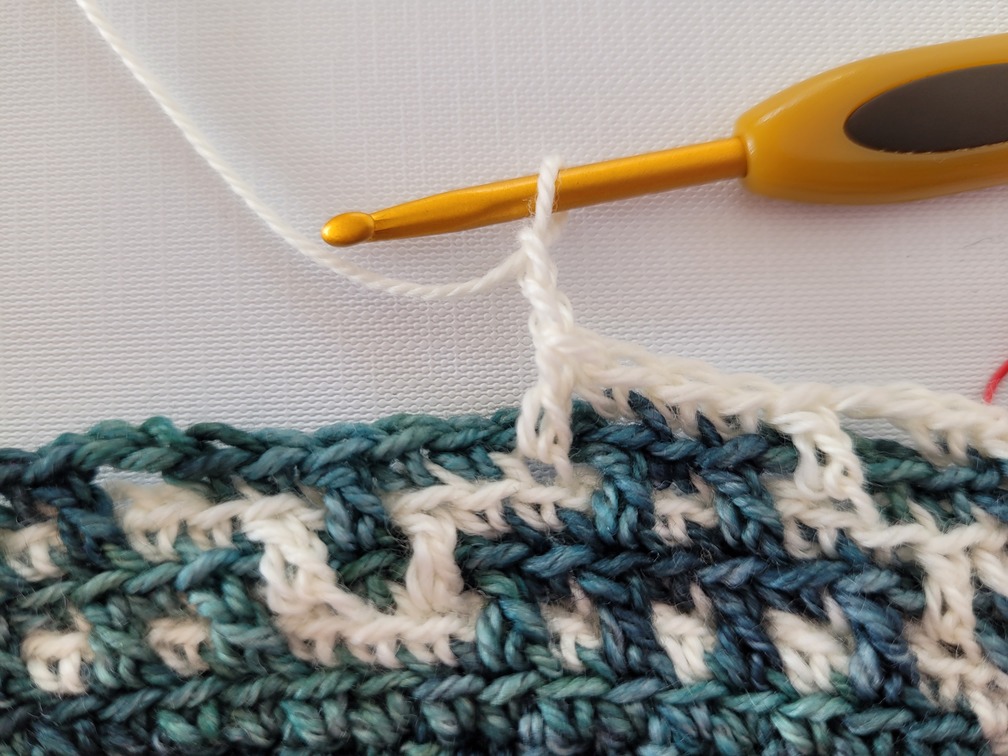
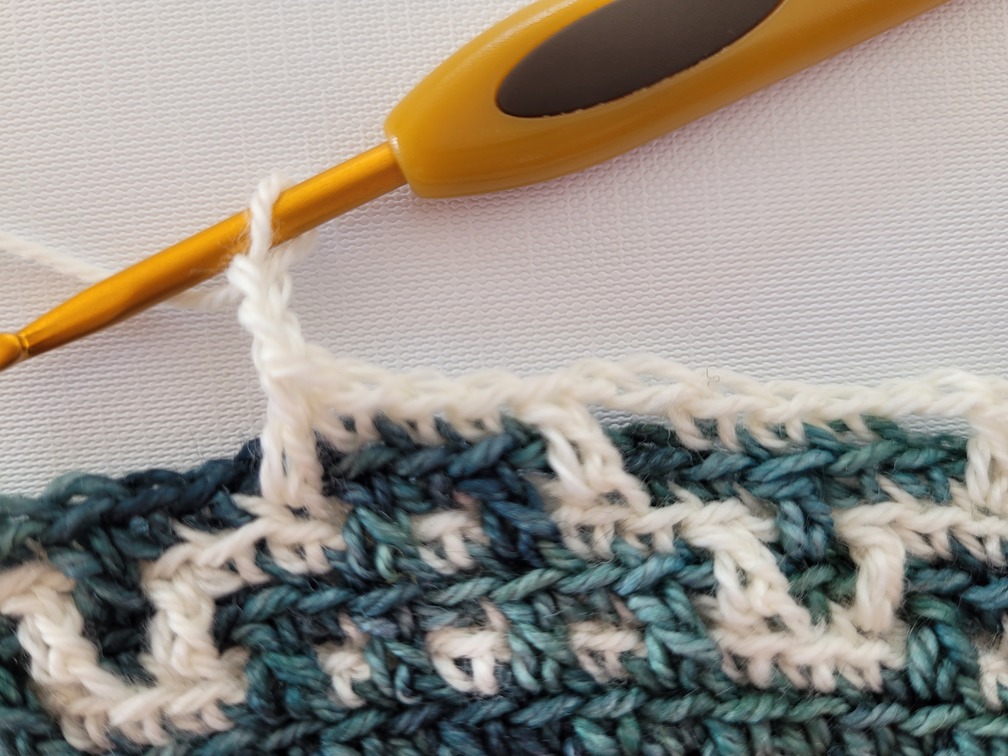
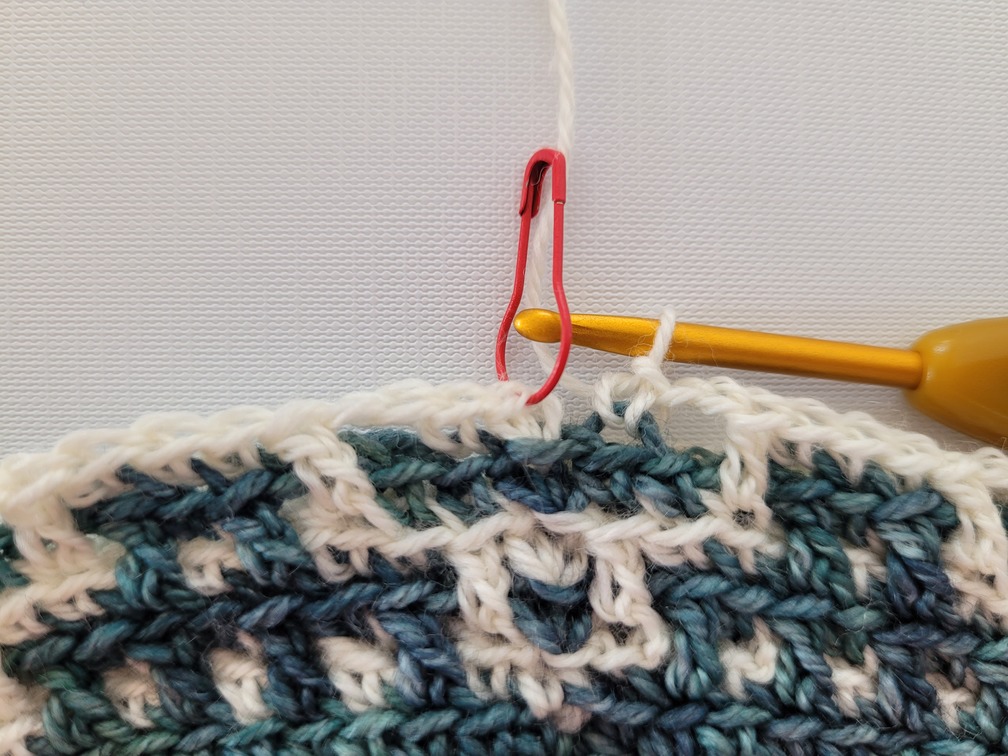
Round 7 (yarn A): ch1, sc1 in BOR (mark this st as a new BOR), ch2, sk 1st, BLmosaicdc1, BLsc2, ch2, sk 1st, BLsc2, BLmosaicdc1, [ch4, sk 3sts, BLmosaicdc1, BLsc2, ch2, sk 1st, BLsc2, BLmosaicdc1] rep around until 1st remain before BOR, ch2, sk 1st, slst to BOR to join. Change to Yarn B in final st.
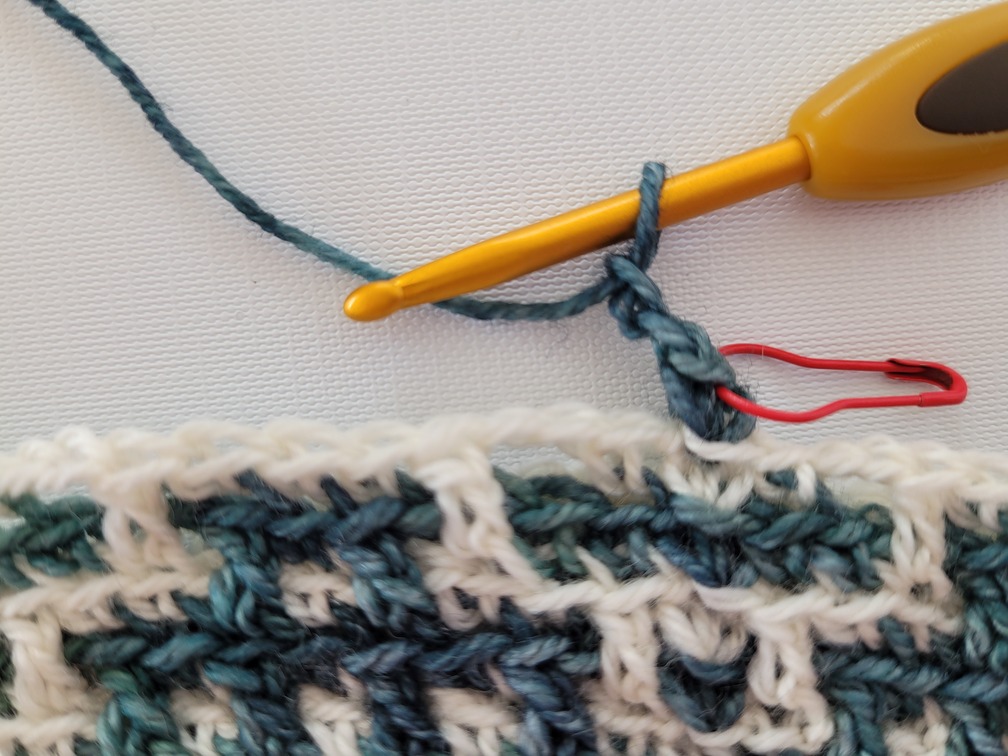
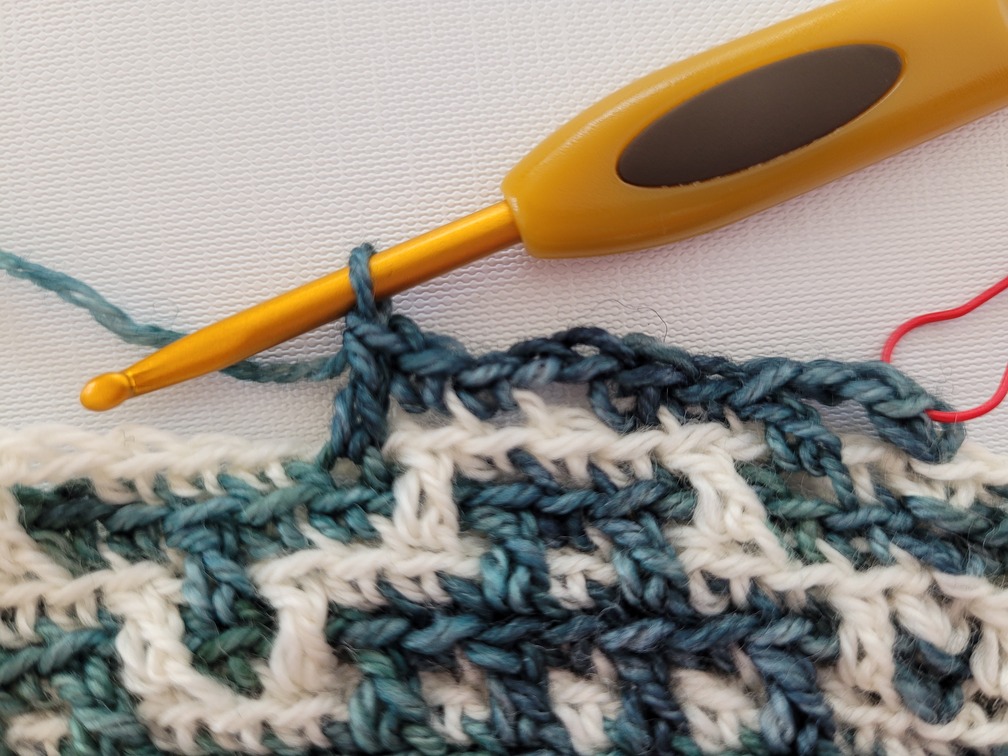
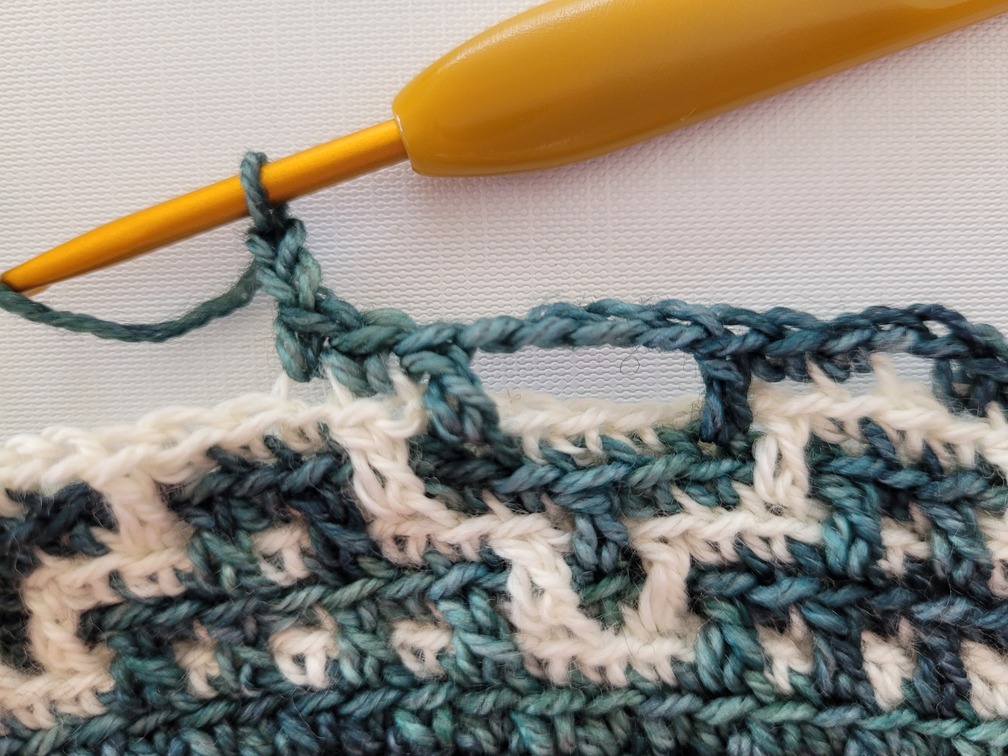

Round 8 (yarn B): ch1, sc1 in BOR (mark this st as a new BOR), BLmosaicdc1, BLsc2, ch2, sk 1st, BLmosaicdc1, ch2, sk 1st, BLsc2, BLmosaicdc1, [BLmosaicdc2, BLsc2, ch2, sk 1st, BLmosaicdc1, ch2, sk 1st, BLsc2, BLmosaicdc1] rep around until BOR, slst to BOR to join. Change to Yarn A in final st.
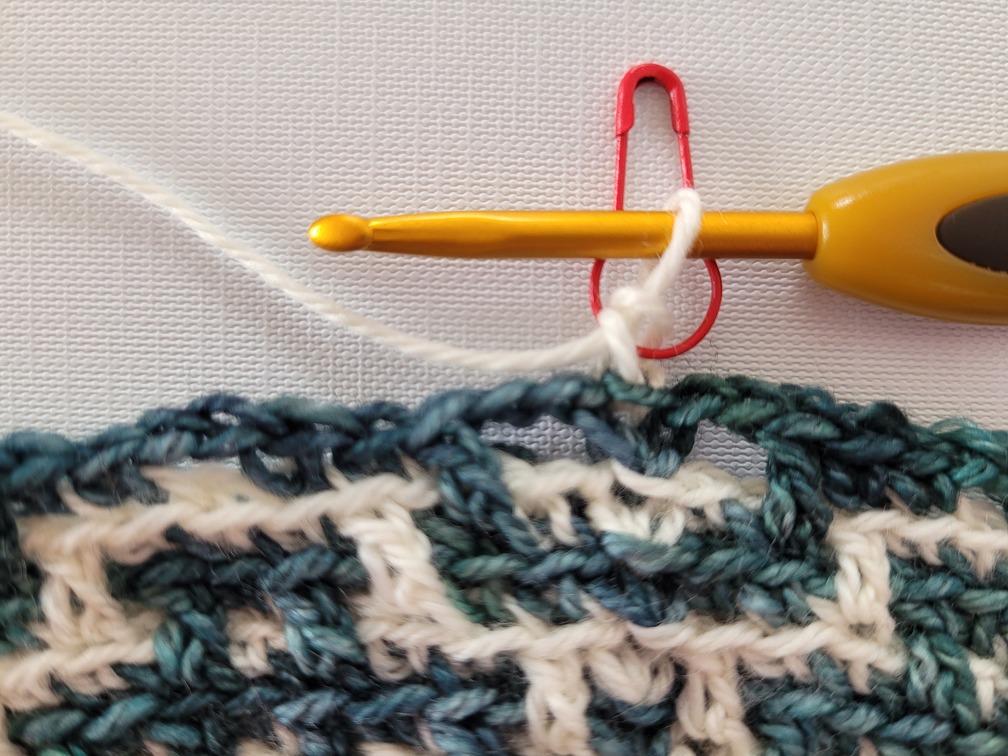
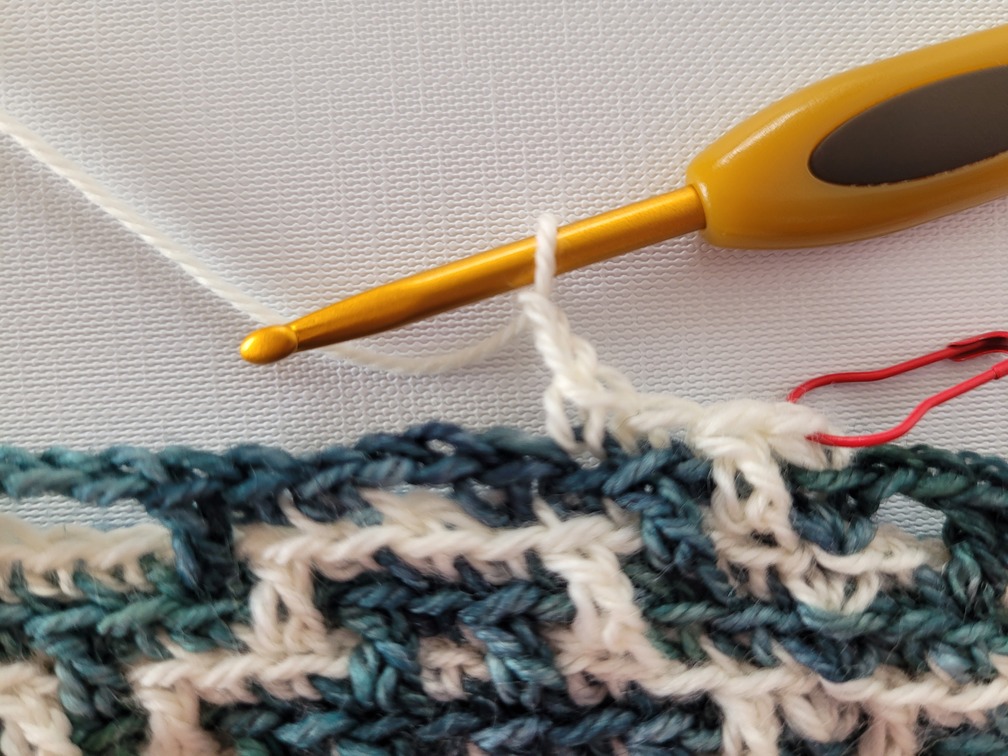
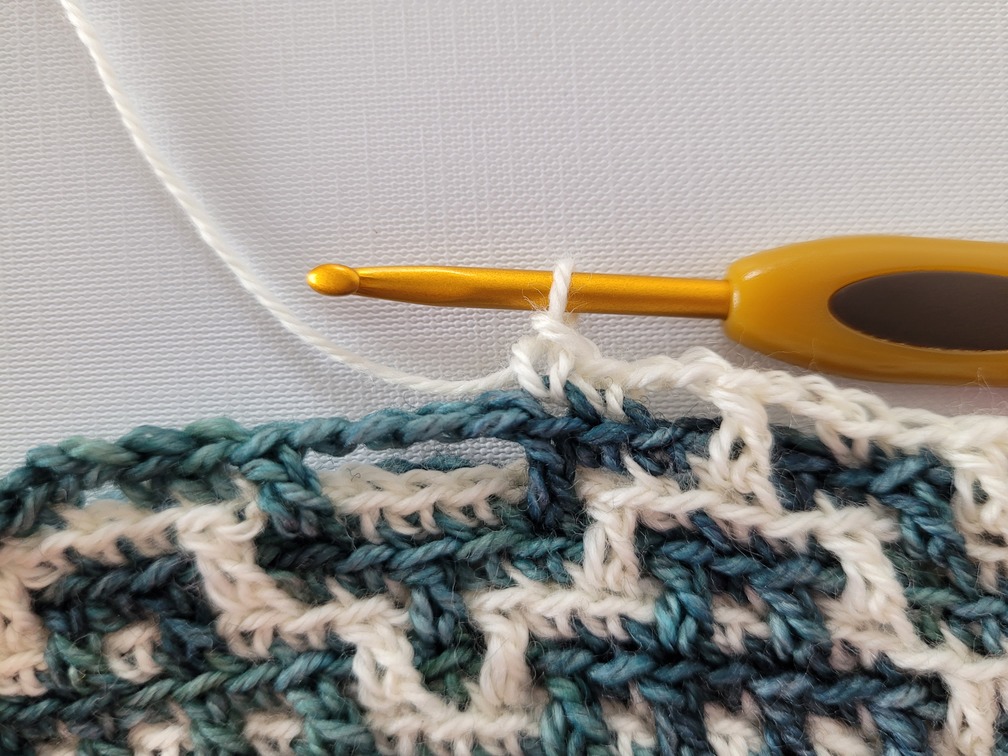

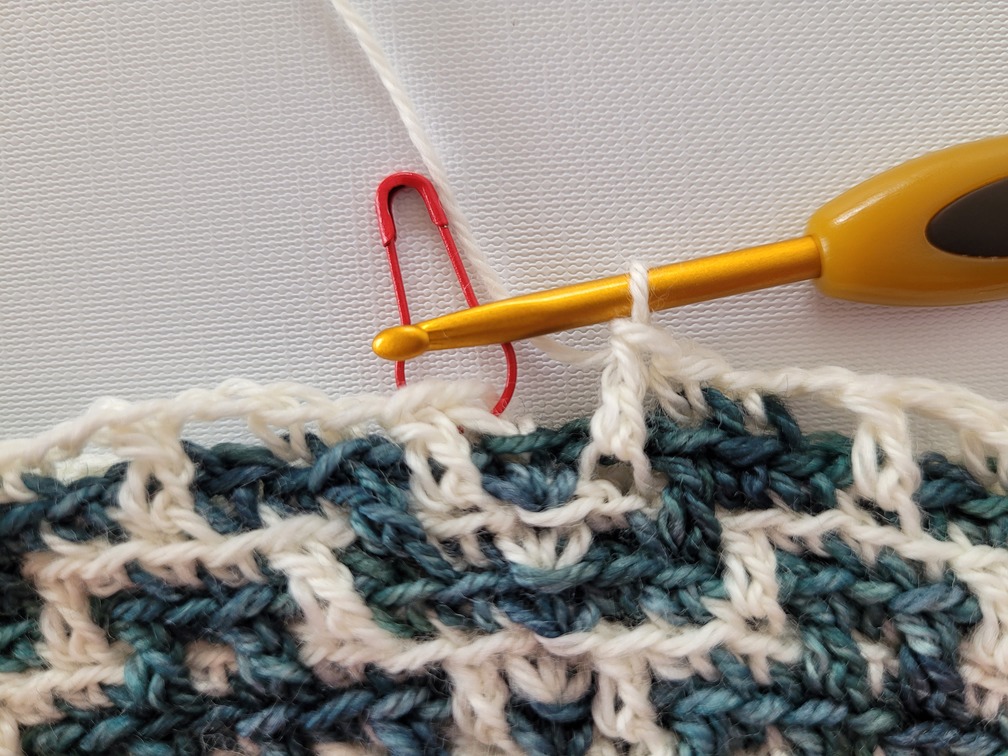
Round 9 (yarn A): ch1, sc1 in BOR (mark this st as a new BOR), ch4, sk 3sts, BLmosaicdc1, BLsc1, BLmosaicdc1, [ch8, sk 7sts, BLmosaicdc1, BLsc1, BLmosaicdc1] rep around until 3sts remain before BOR, ch4, sk 3sts, slst to BOR to join. Change to Yarn B in final st.
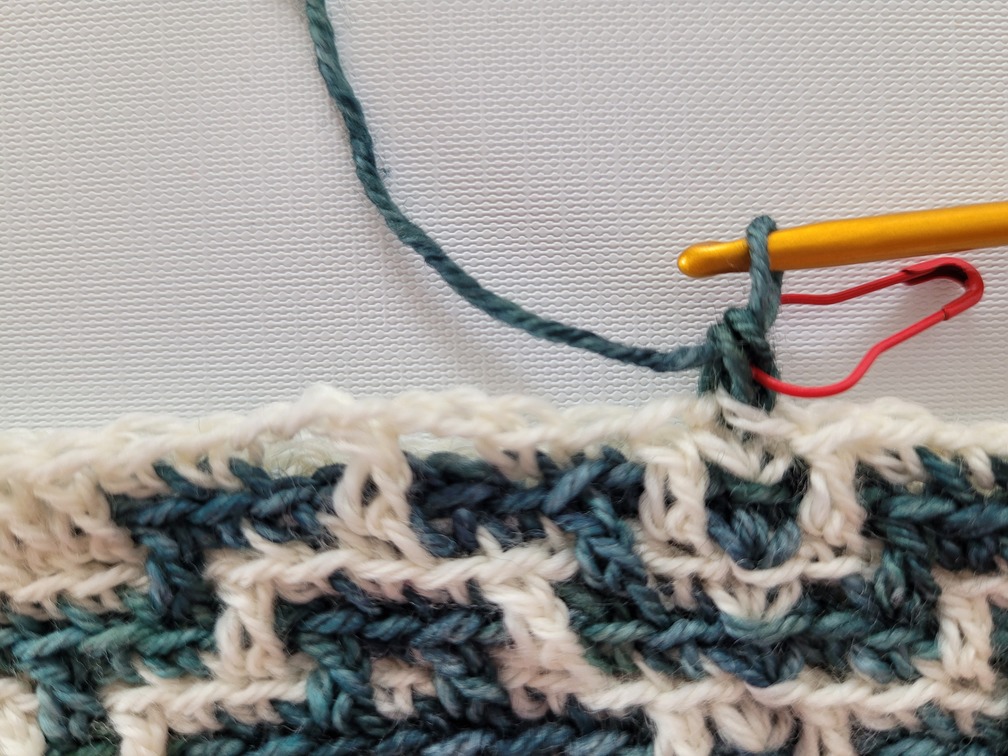

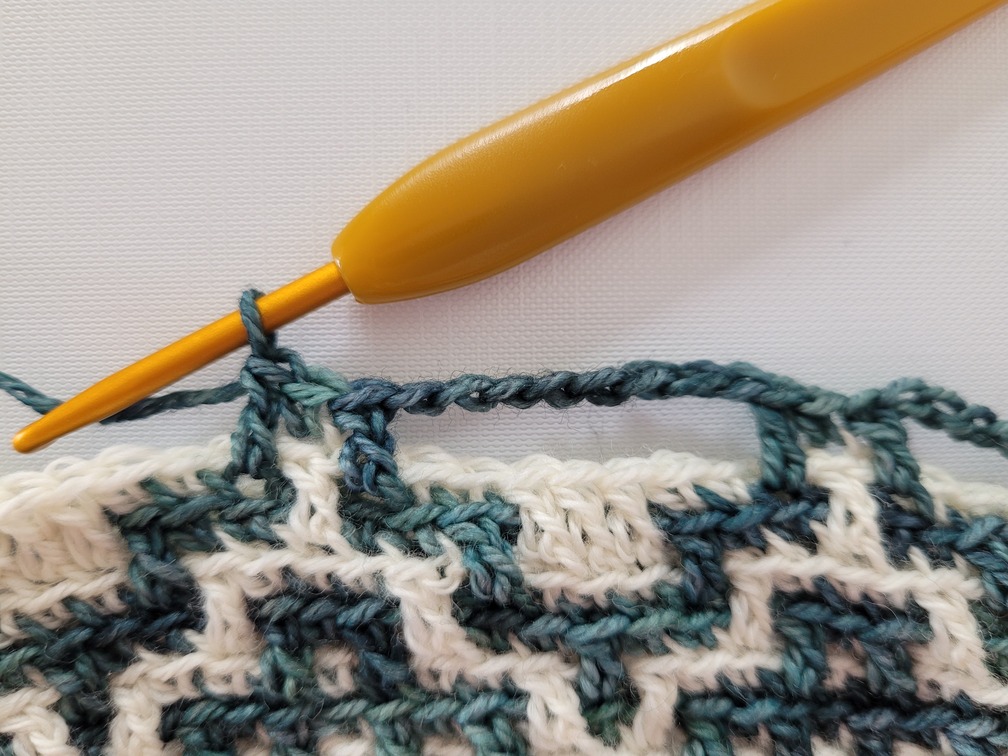

Round 10 (yarn B): ch1, sc1 in BOR (mark this st as a new BOR), BLmosaicdc3, BLsc3, BLmosaicdc3, [BLmosaicdc4, BLsc3, BLmosaicdc3] rep around until BOR, slst to BOR to join. Change to Yarn A in final st.

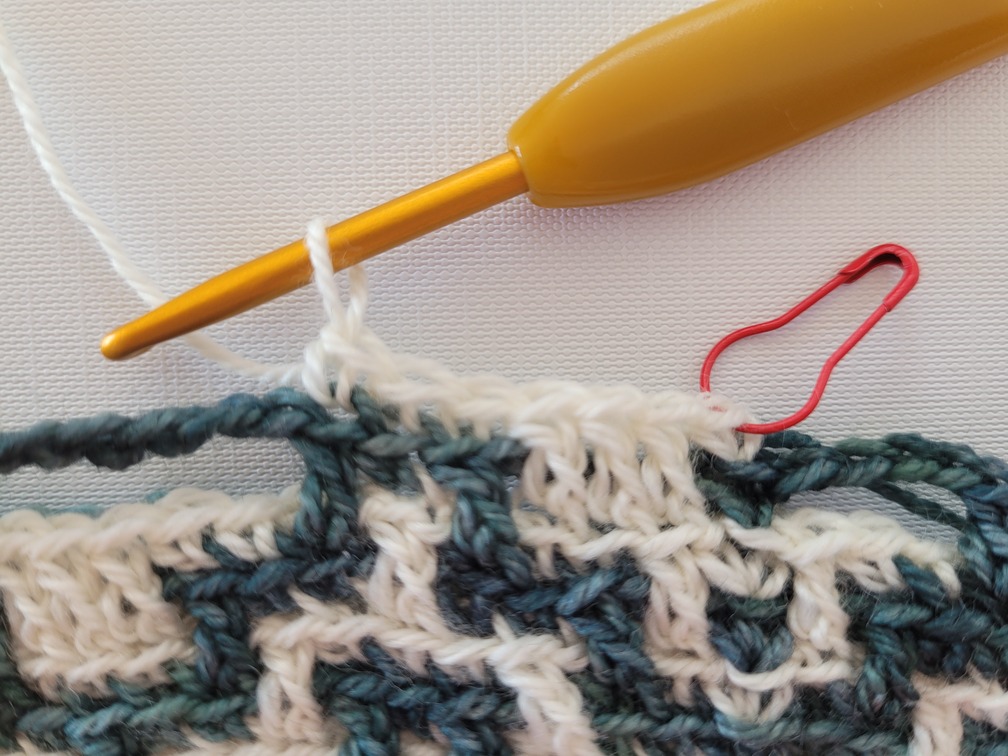
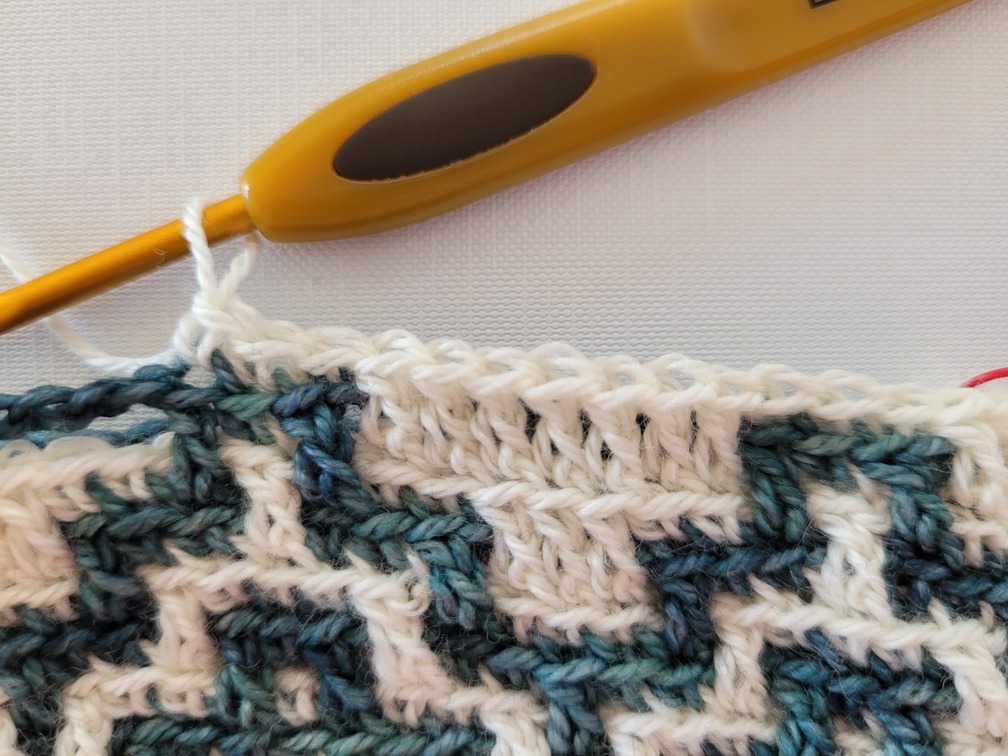
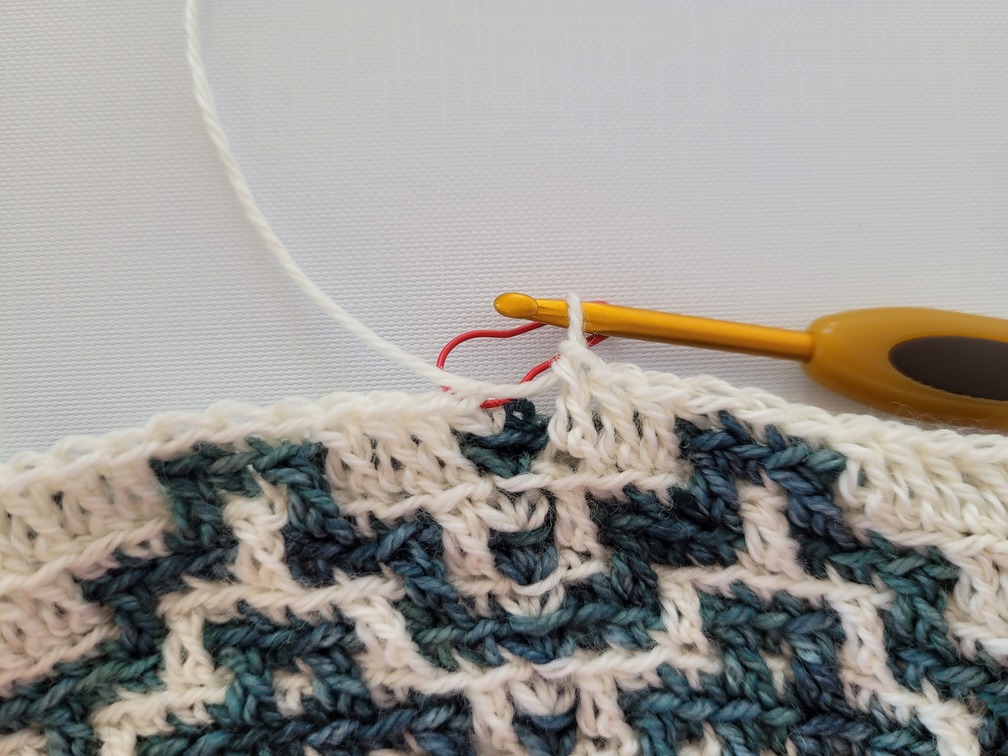
Round 11 (yarn A): ch1, sc1 in BOR (mark this st as a new BOR), BLsc1, ch8, sk 7sts, BLsc1, [BLsc2, ch8, sk 7sts, BLsc1] rep around until BOR, ch4, sk 3sts, slst to BOR to join. Change to Yarn B in final st.
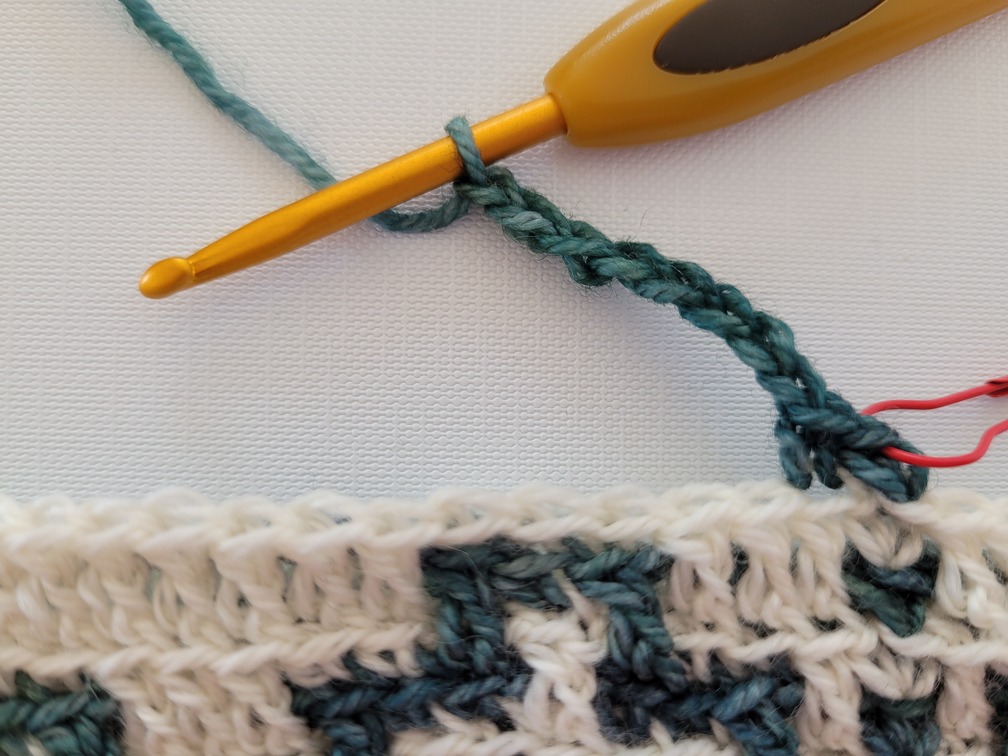
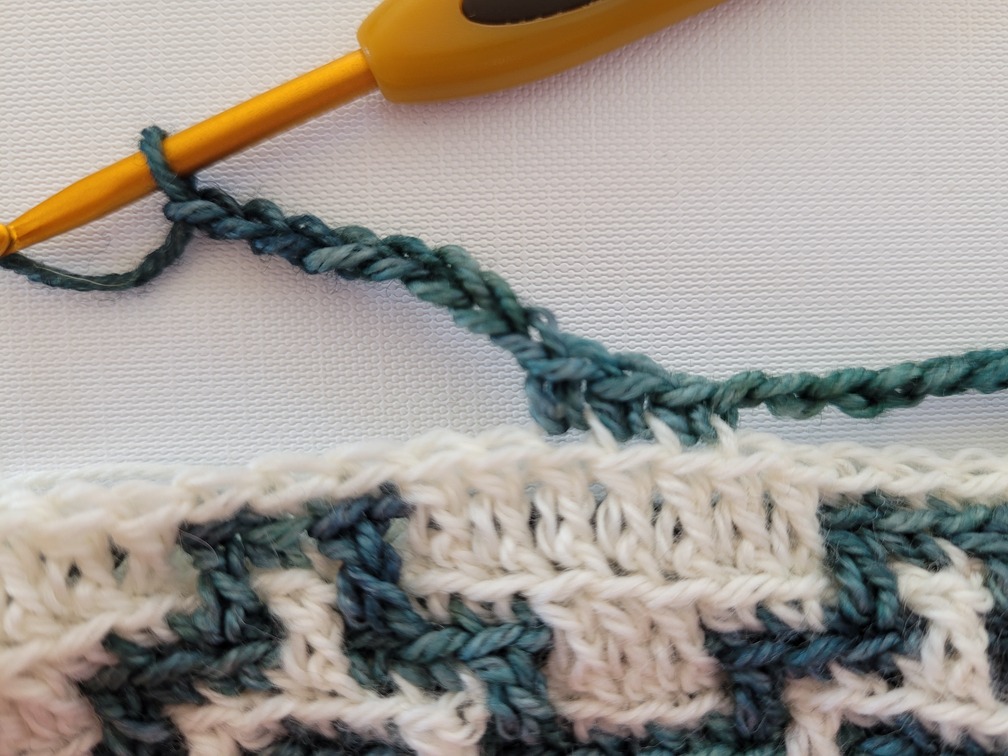

Round 12 (yarn B): ch1, sc1 in BOR (mark this st as a new BOR), ch2, sk 1st, BLmosaicdc7, ch2, sk 1st, [BLsc1, ch2, sk 1st, BLmosaicdc7, ch2, sk 1st] rep around until BOR, slst to BOR to join. Change to Yarn A in final st.
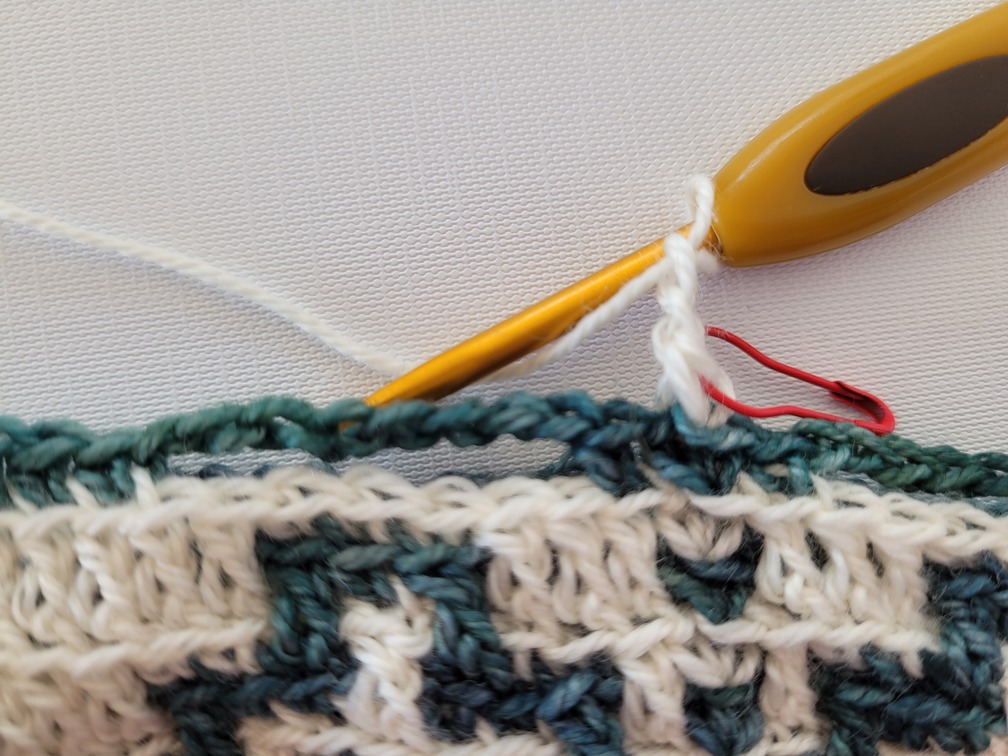
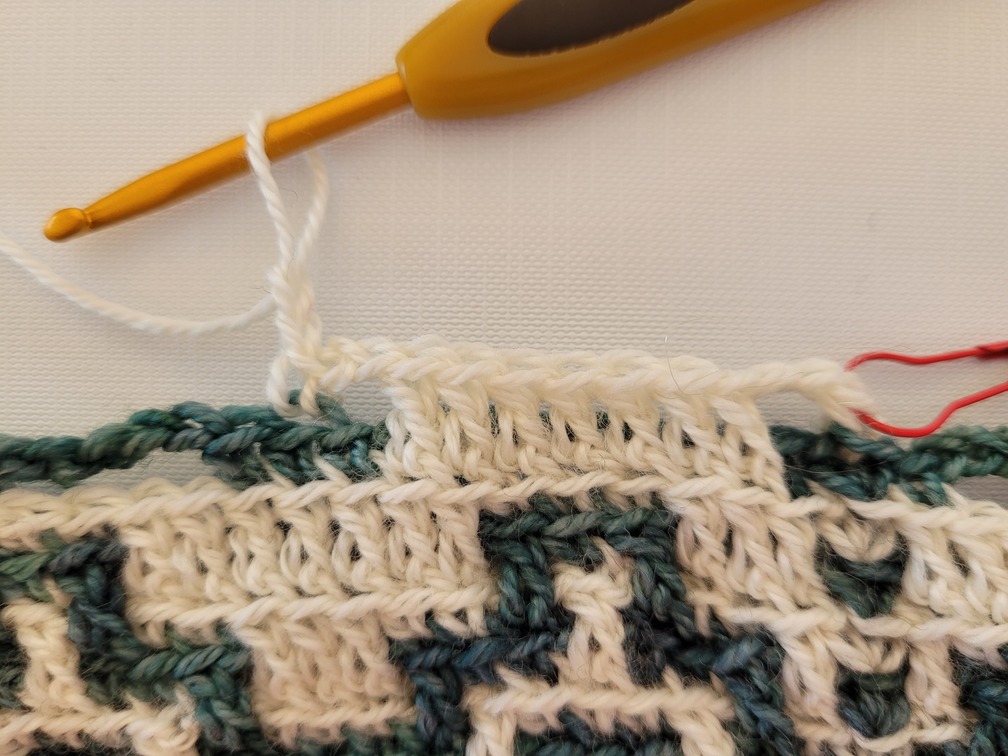
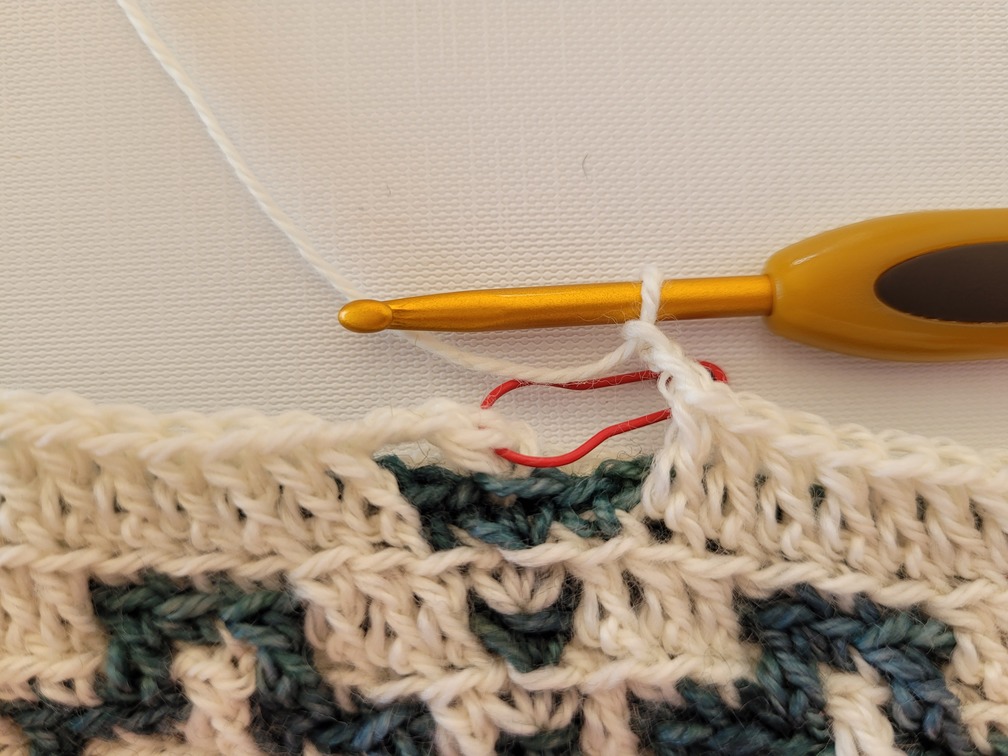
Round 13 (yarn A): ch1, sc1 in BOR (mark this st as a new BOR), BLmosaicdc1, BLsc2, ch4, sk 3sts, BLsc2, BLmosaicdc1, [ch2, sk 1st, BLmosaicdc1, BLsc2, ch4, sk 3sts, BLsc2, BLmosaicdc1] rep around until BOR, slst to BOR to join. Change to Yarn B in final st.
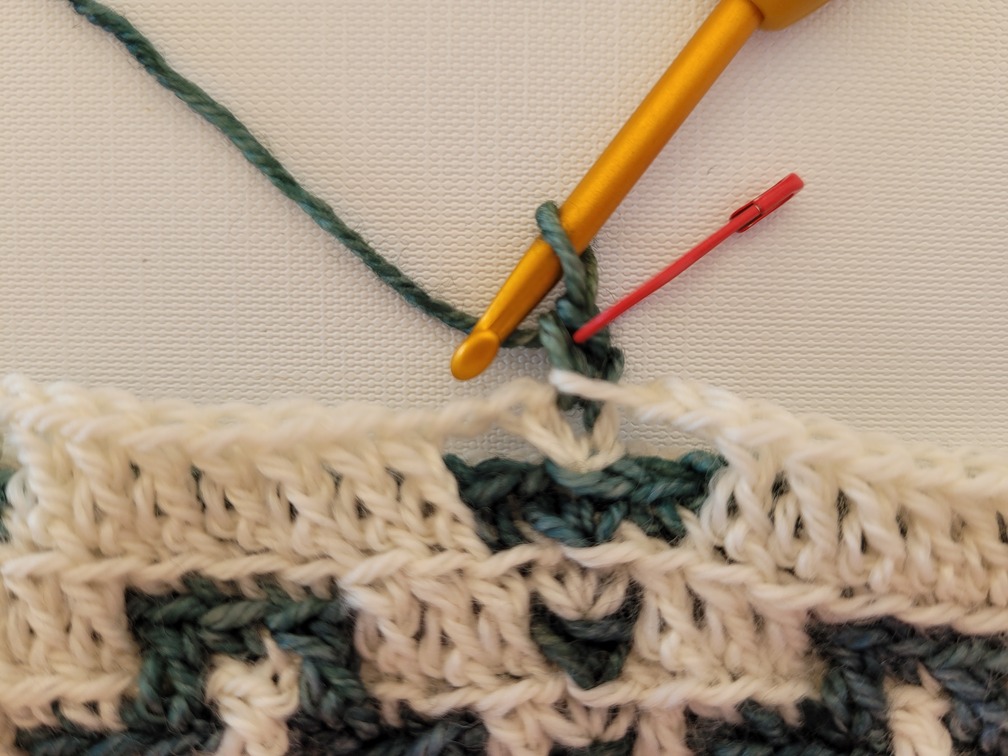
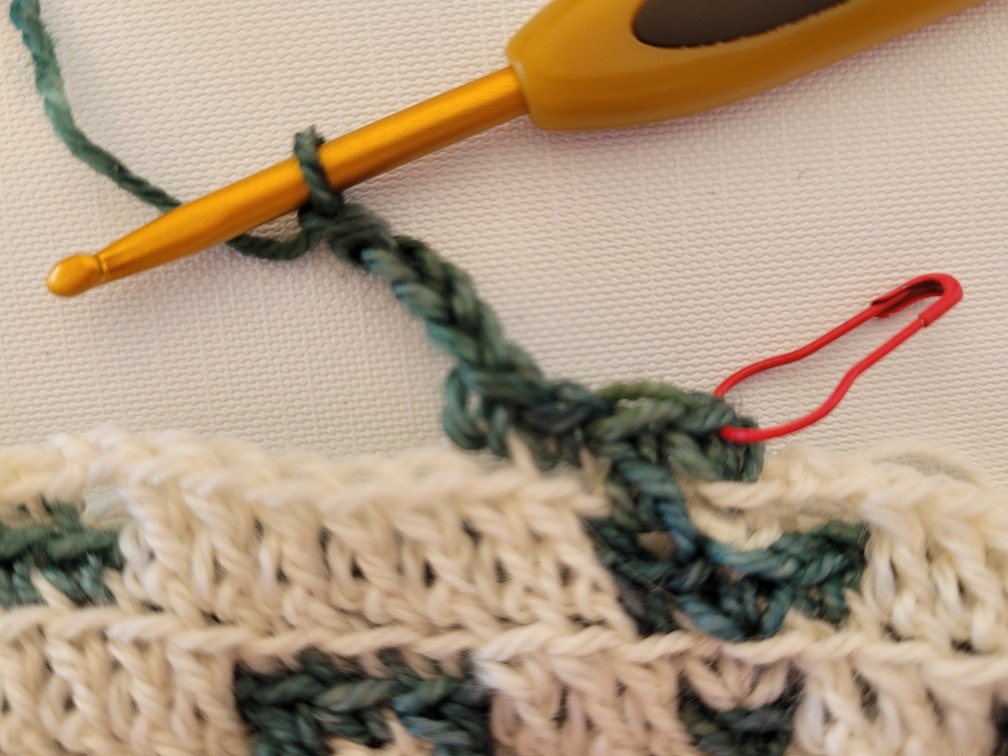

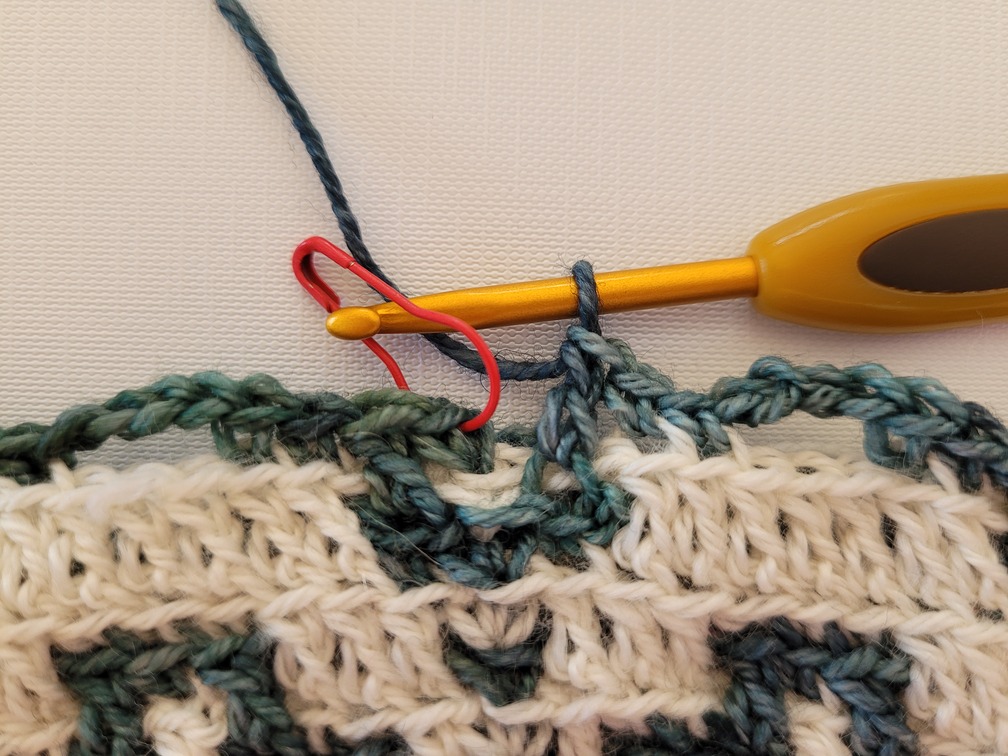
Round 14 (yarn B): ch1, sc1 in BOR (mark this st as a new BOR), BLsc1, ch3, sk 2sts, BLmosaicdc3, ch3, sk 2sts, BLsc1, [BLmosaicdc1, BLsc1, ch3, sk 2sts, BLmosaicdc3, ch3, sk 2sts, BLsc1] rep around until BOR, slst to BOR to join. Change to Yarn A in final st.
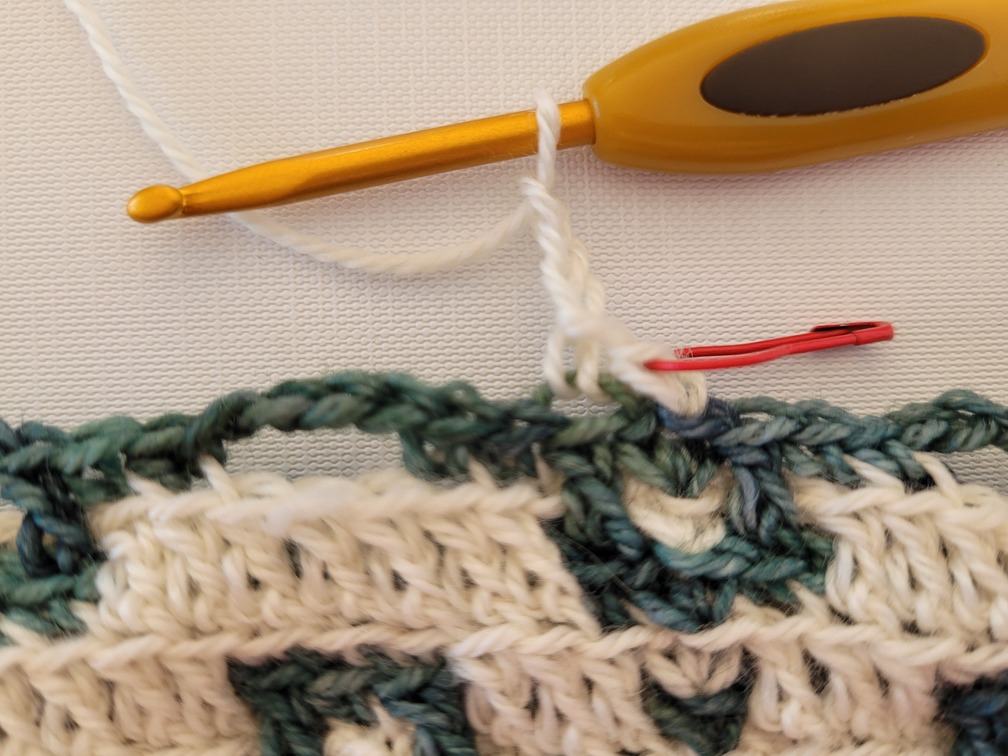
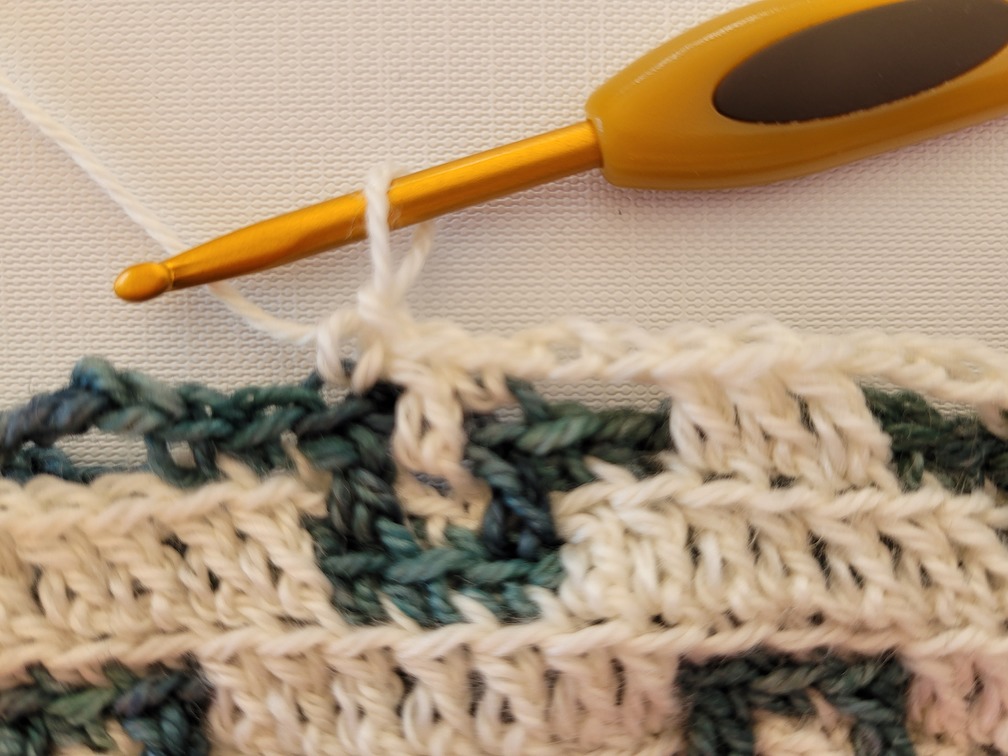
Round 15 (yarn A): ch1, sc1 in BOR (mark this st as a new BOR), ch2, sk 1st, BLmosaicdc2, BLsc1, ch2, sk 1st, BLsc1, BLmosaicdc2, [ch4, sk 3sts, BLmosaicdc2, BLsc1, ch2, sk 1st, BLsc1, BLmosaicdc2] rep around until1st remain before BOR, ch2, sk 1st, slst to BOR to join. Change to Yarn B in final st.
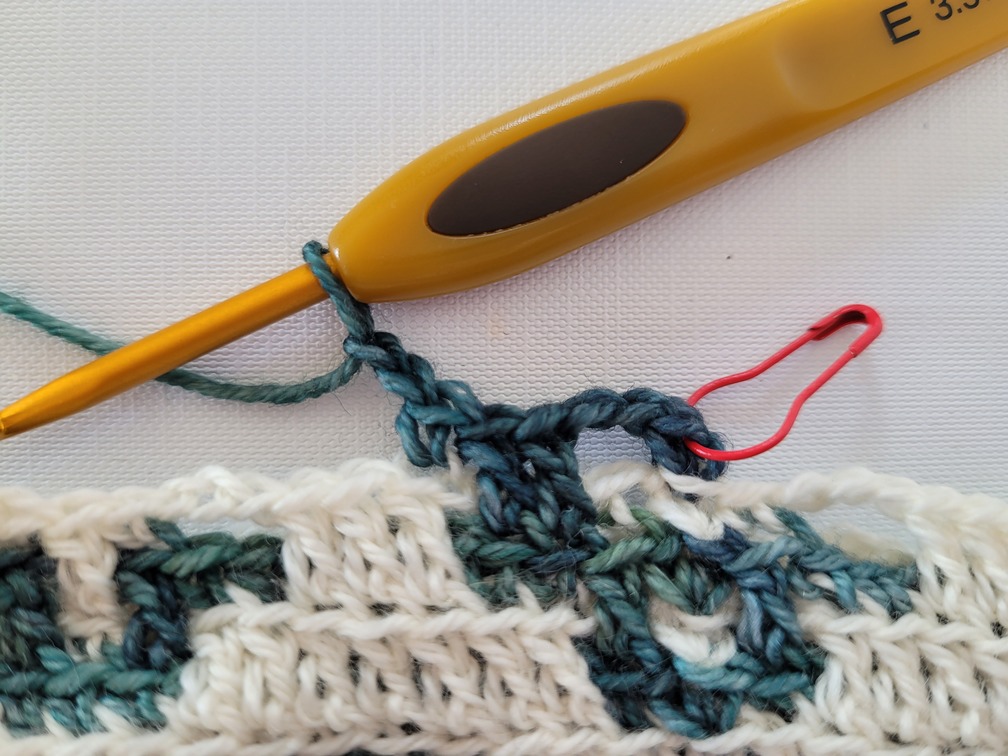



Next, Repeat Rows 8 – 15.
Next, Repeat Rows 8 – 13.
Round 30 (yarn B): ch1, sc1 in BOR (mark this st as a new BOR), BLsc2, ch2, sk 1st, BLmosaicdc3, ch2, sk 1st, BLsc2, [BLmosaicdc1, BLsc2, ch2, sk 1st, BLmosaicdc3, ch2, sk 1st, BLsc2] rep around until BOR, slst to BOR to join. Change to Yarn A in final st.
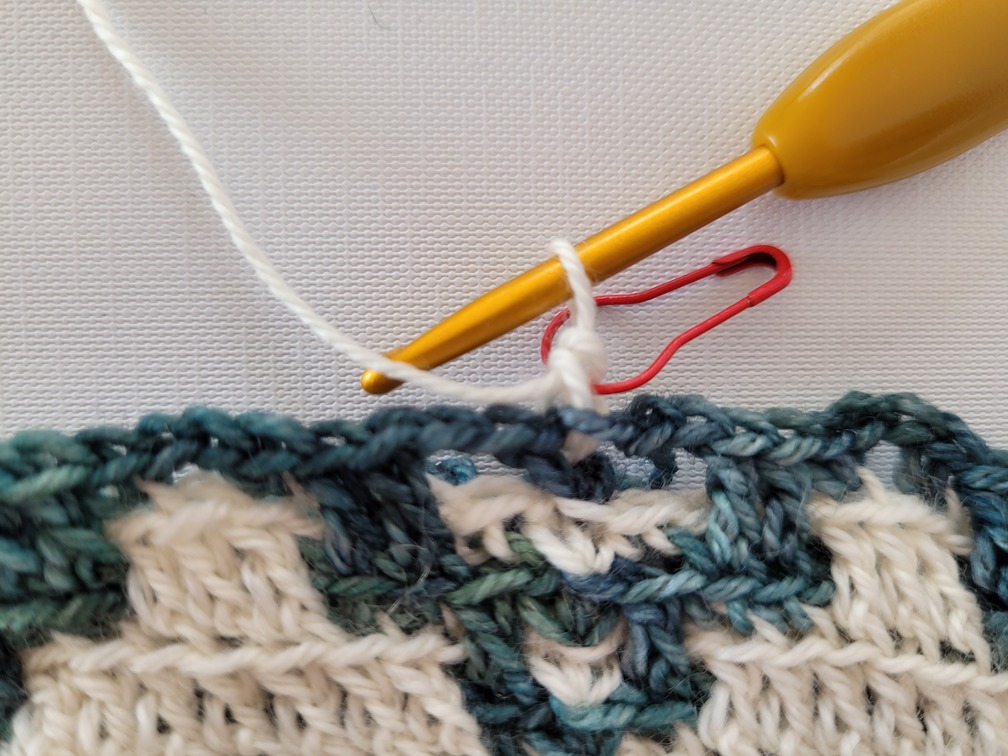
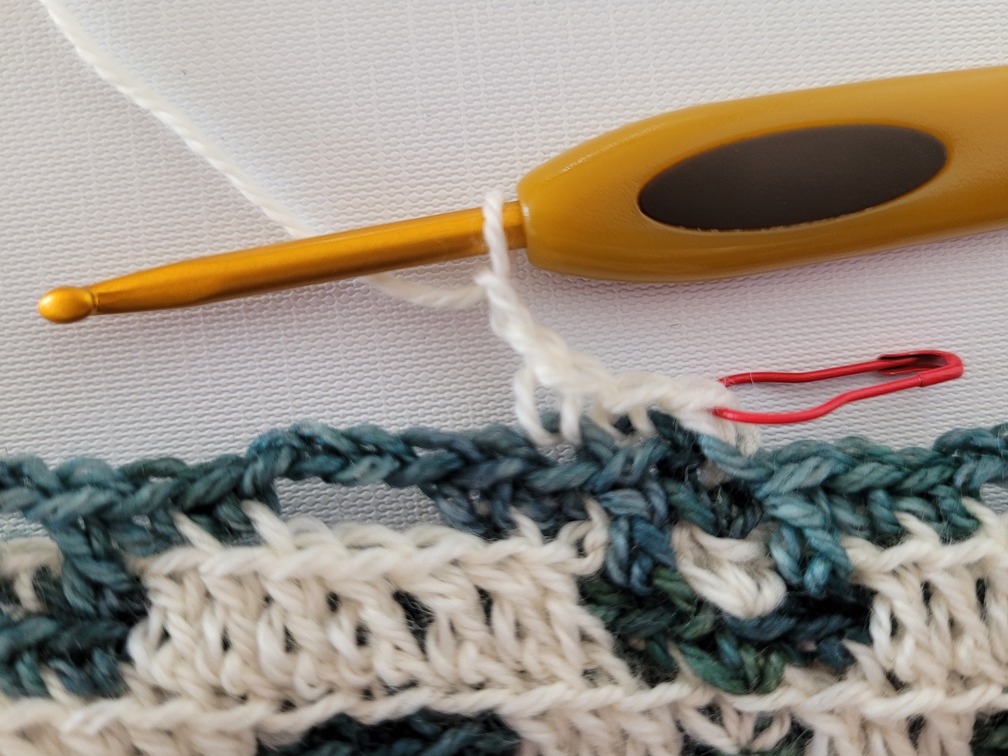
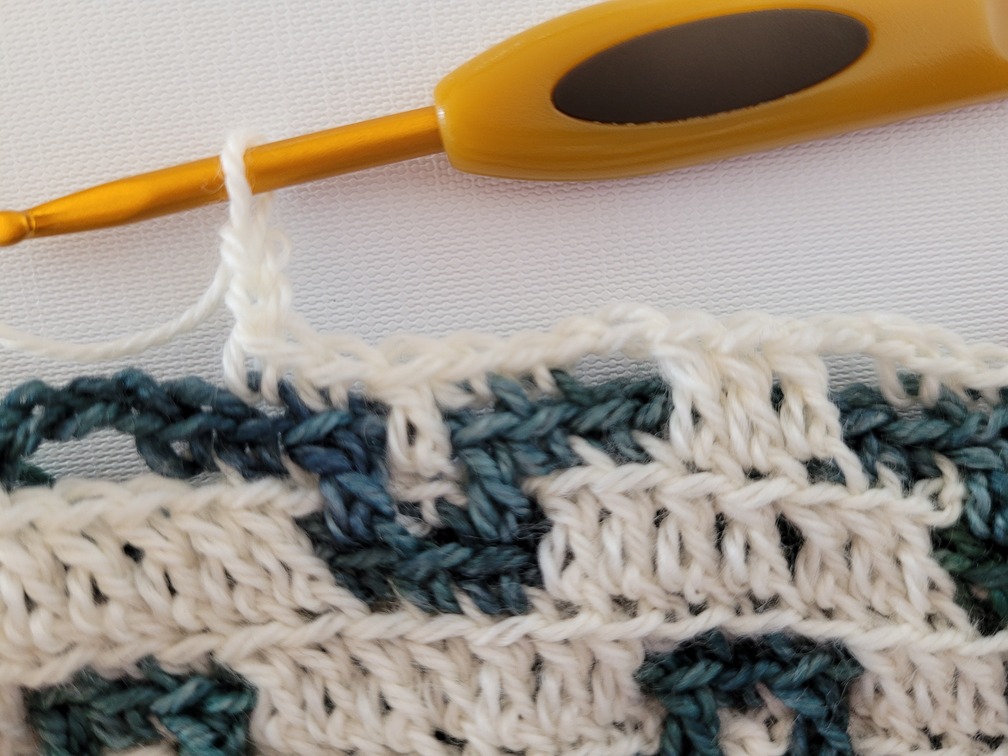
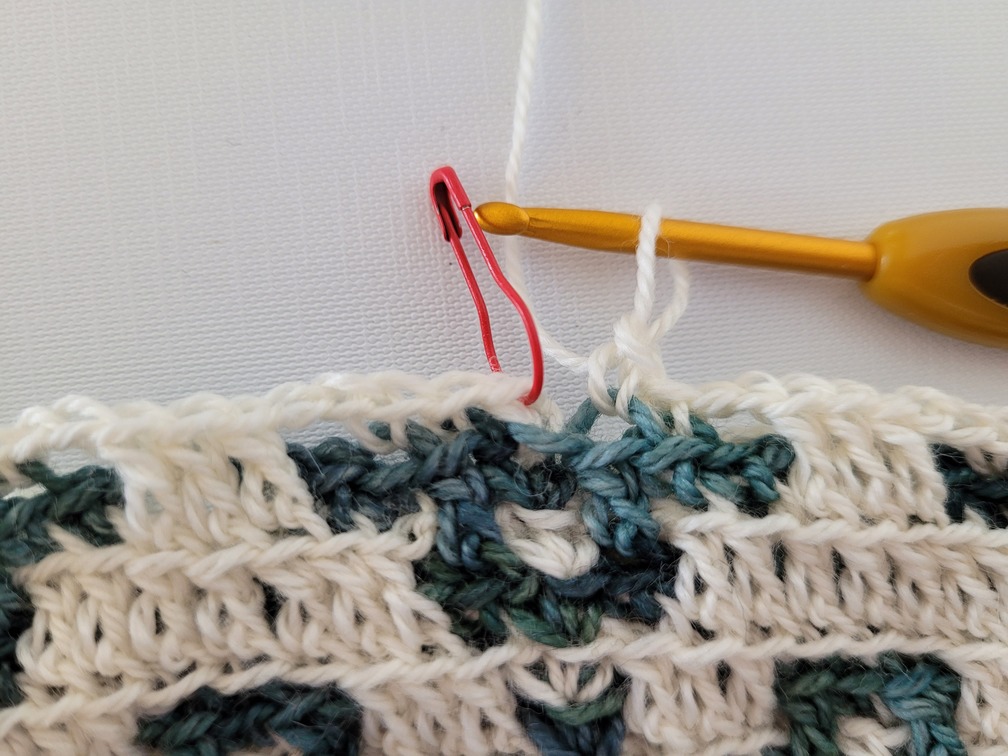
Round 31 (yarn A): ch1, sc1 in BOR (mark this st as a new BOR), BLsc1, ch2, sk 1st, BLmosaicdc1, BLsc3, BLmosaicdc1, ch2, sk 1st, BLsc1, [BLsc2, ch2, sk 1st, BLmosaicdc1, BLsc3, BLmosaicdc1, ch2, sk 1st, BLsc1] rep around until BOR, slst to BOR to join. Change to Yarn B in final st.
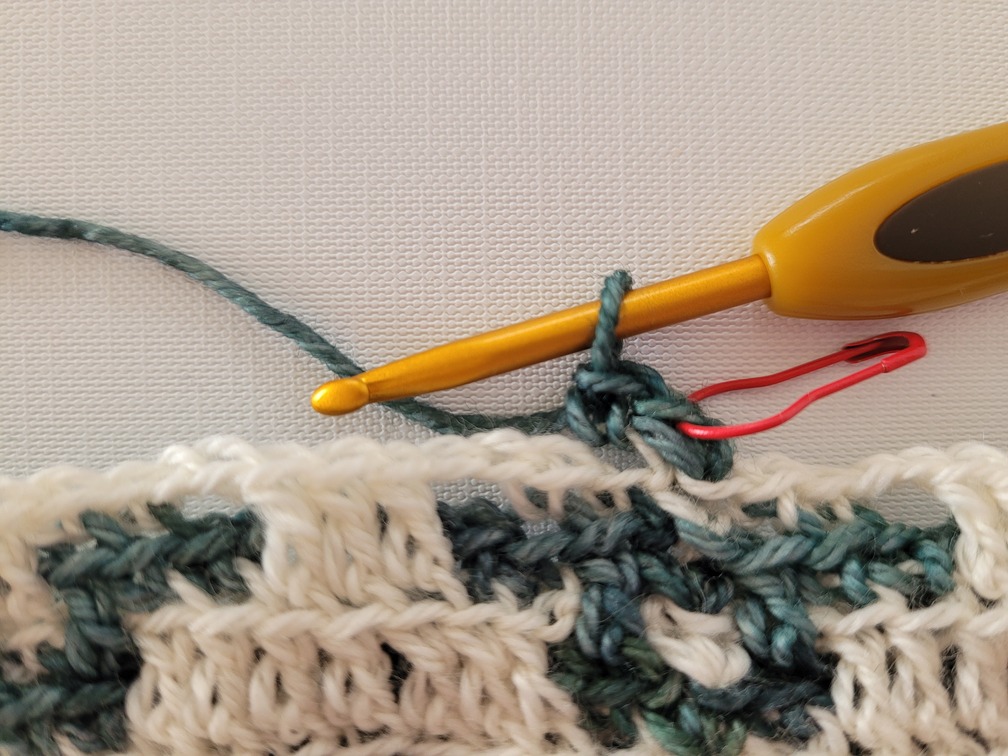
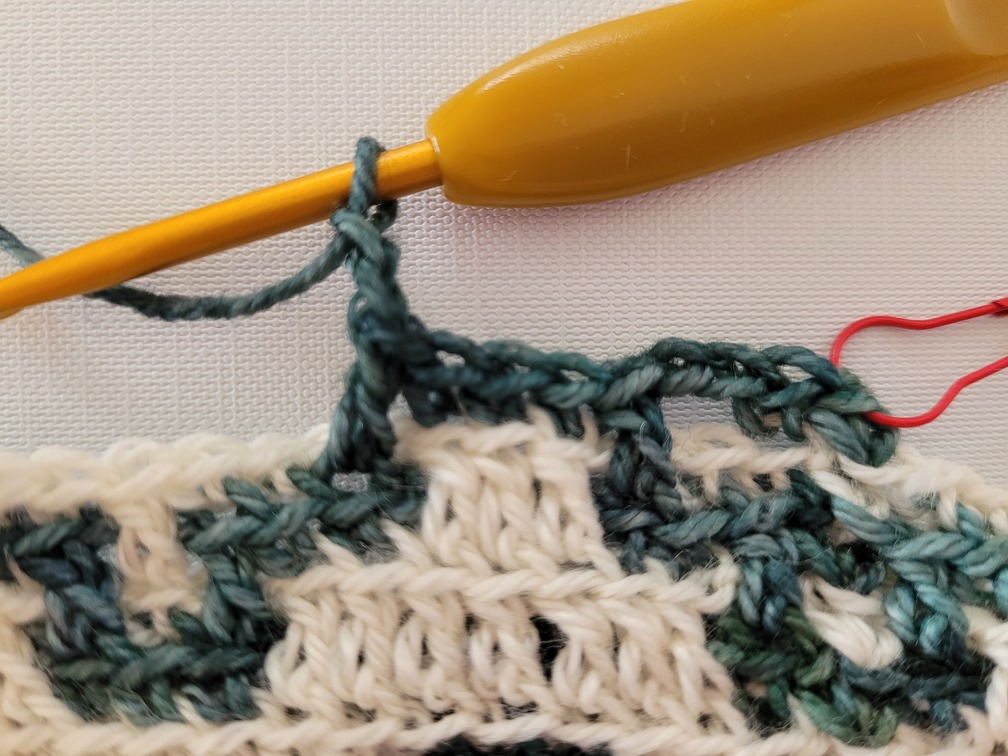
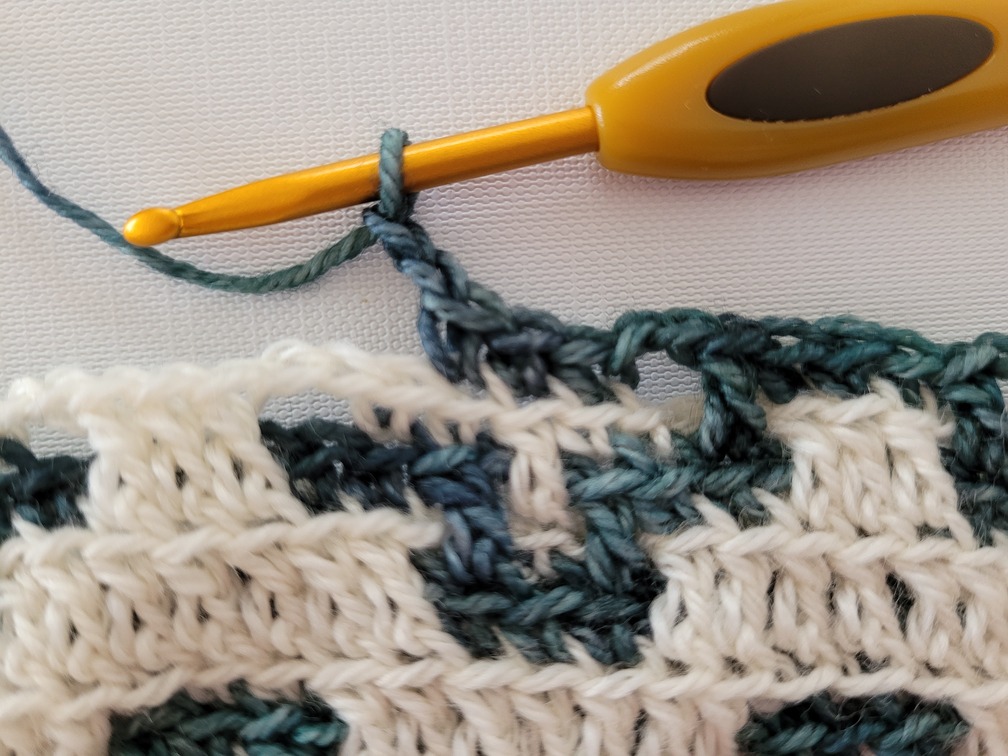
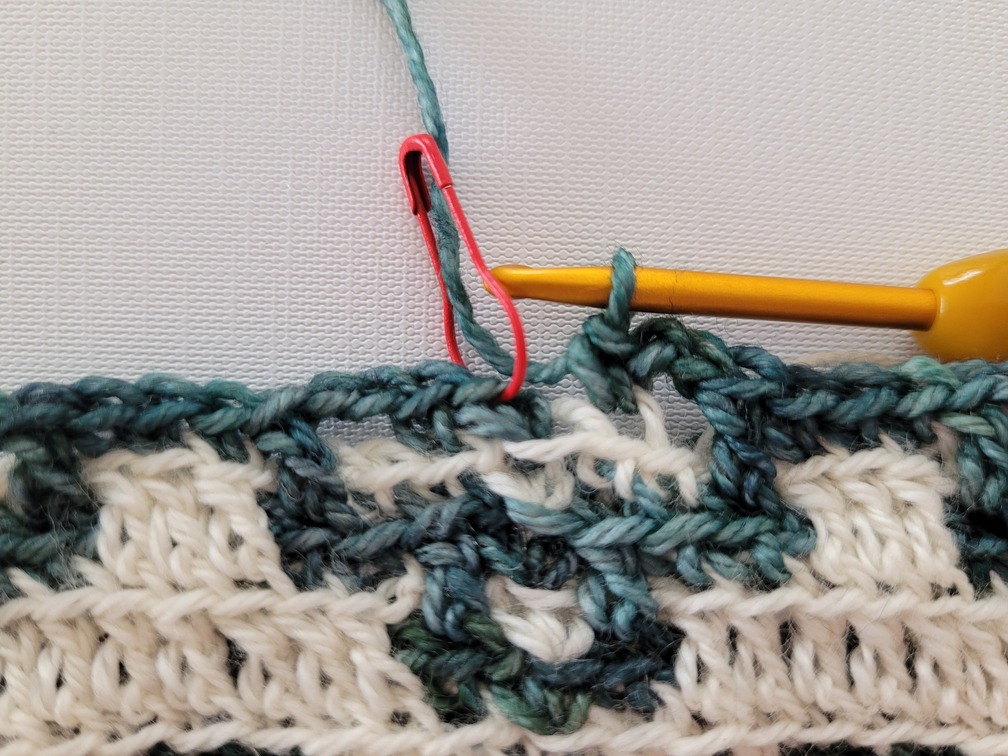
Round 32 (yarn B): ch1, sc1 in BOR (mark this st as a new BOR), ch2, sk 1st, BLmosaicdc1, BLsc2, ch2, sk 1st, BLsc2, BLmosaicdc1, ch2, sk 1st, [BLsc1, ch2, sk 1st, BLmosaicdc1, BLsc2, ch2, sk 1st, BLsc2, BLmosaicdc1, ch2, sk 1st] rep around until BOR, slst to BOR to join. Change to Yarn A in final st.

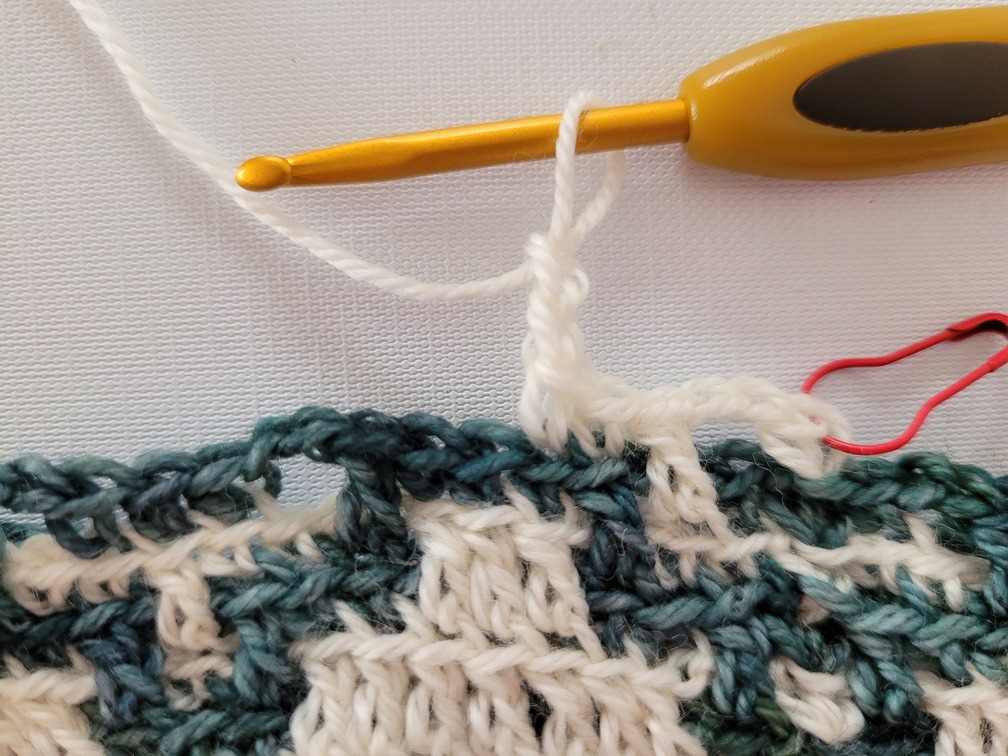
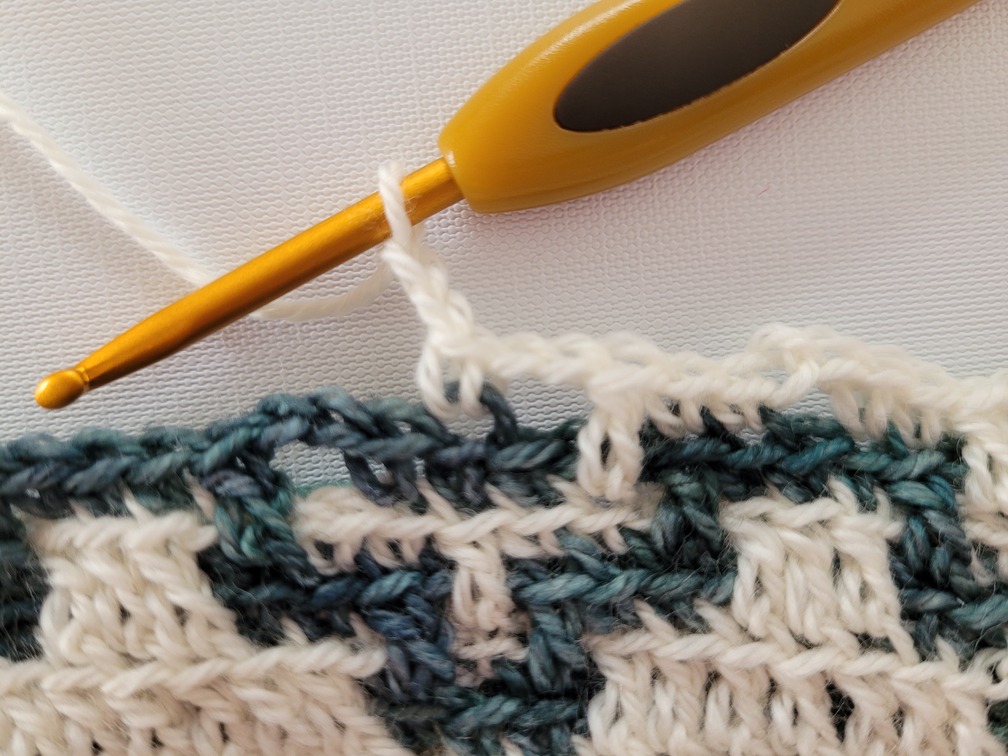
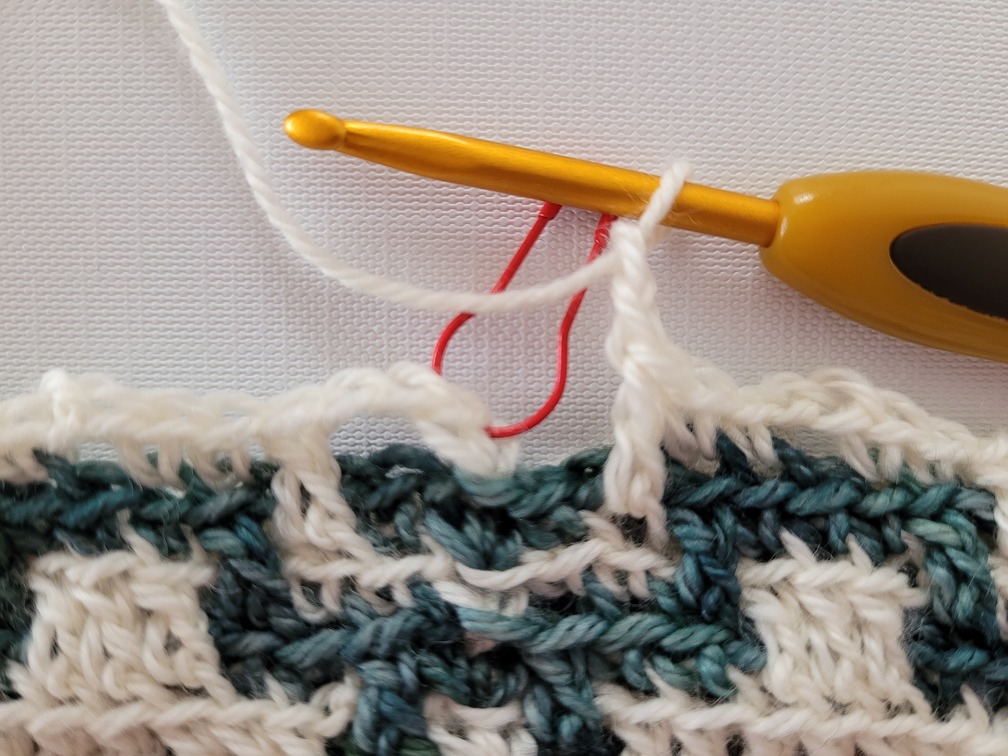
Round 33 (yarn A): ch1, sc1 in BOR (mark this st as a new BOR), BLmosaicdc1, BLsc2, ch2, sk 1st, BLmosaicdc1, ch2, sk 1st, BLsc2, BLmosaicdc1, [BLsc1, BLmosaicdc1, BLsc2, ch2, sk 1st, BLmosaicdc1, ch2, sk 1st, BLsc2, BLmosaicdc1] rep around until BOR, slst to BOR to join. Change to Yarn B in final st.
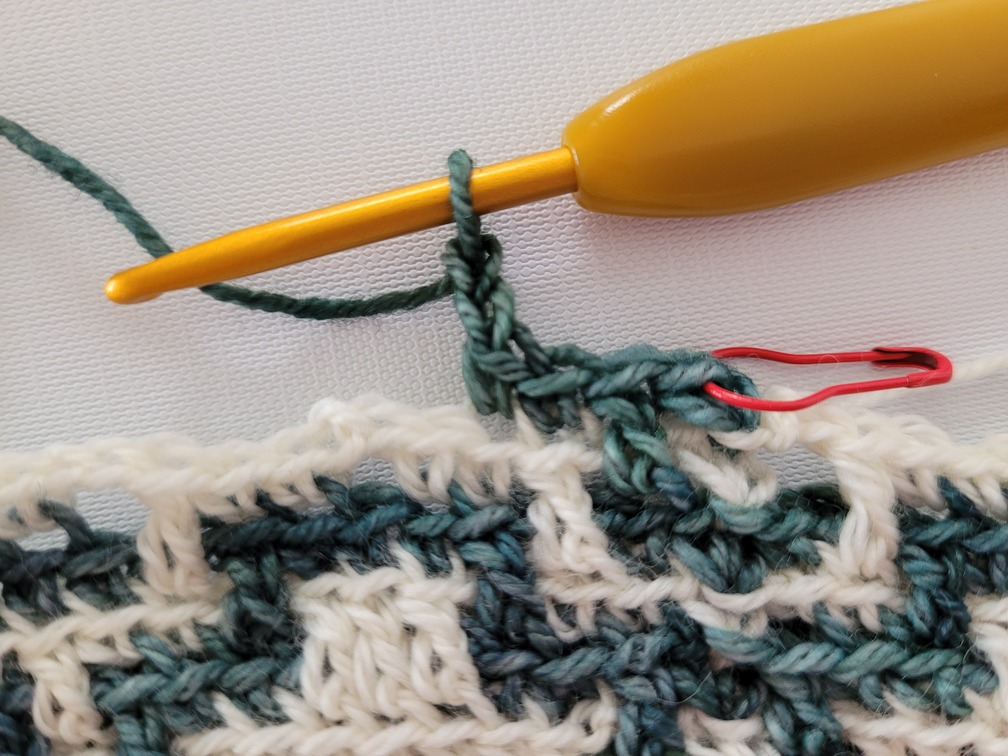

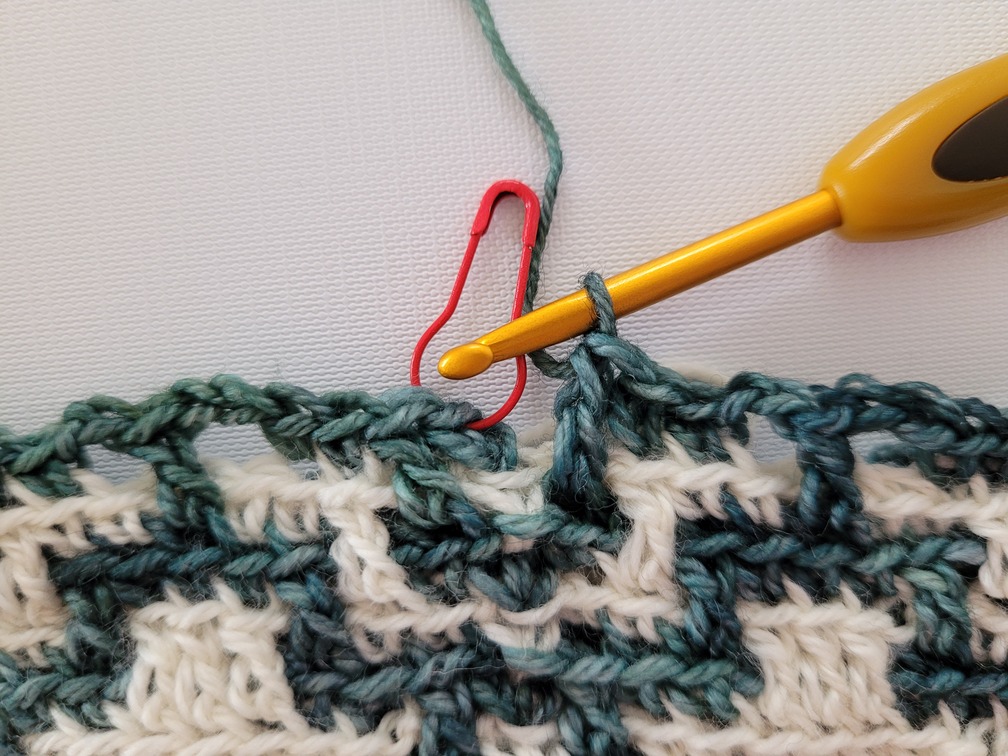
Round 34 (yarn B): ch1, sc1 in BOR (mark this st as a new BOR), ch2, sk 1st, BLsc1, ch2, sk 1st, BLmosaicdc1, BLsc1, BLmosaicdc1, ch2, sk 1st, BLsc1, ch2, sk 1st, [BLsc1, ch2, sk 1st, BLsc1, ch2, sk 1st, BLmosaicdc1, BLsc1, BLmosaicdc1, ch2, sk 1st, BLsc1, ch2, sk 1st] rep around until BOR, slst to BOR to join. Change to Yarn A in final st.

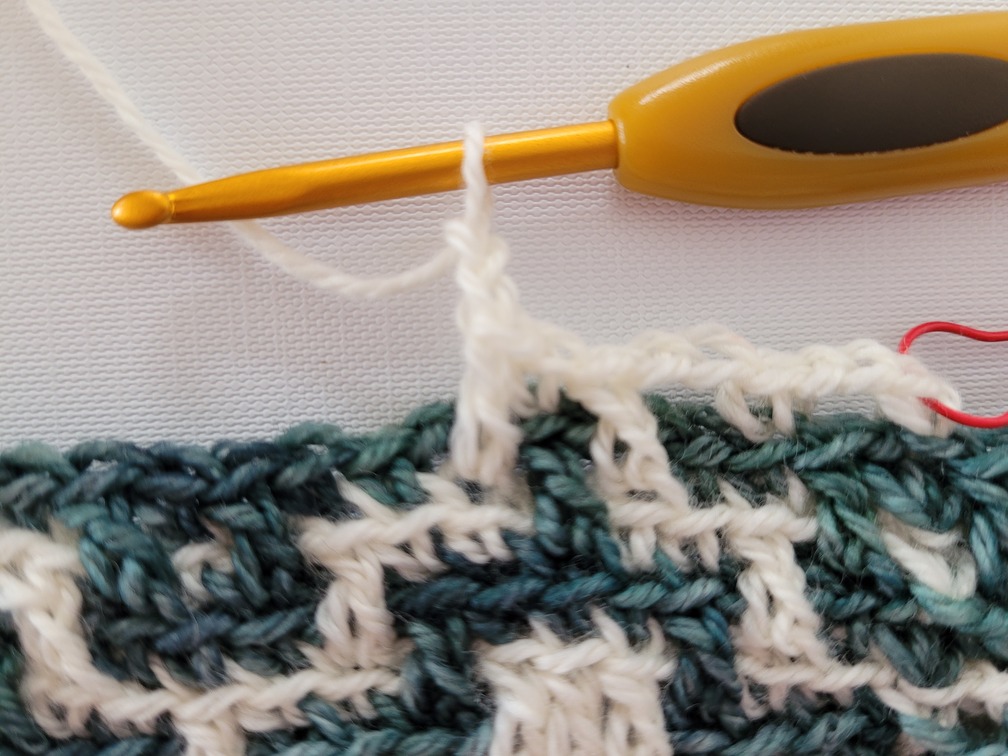
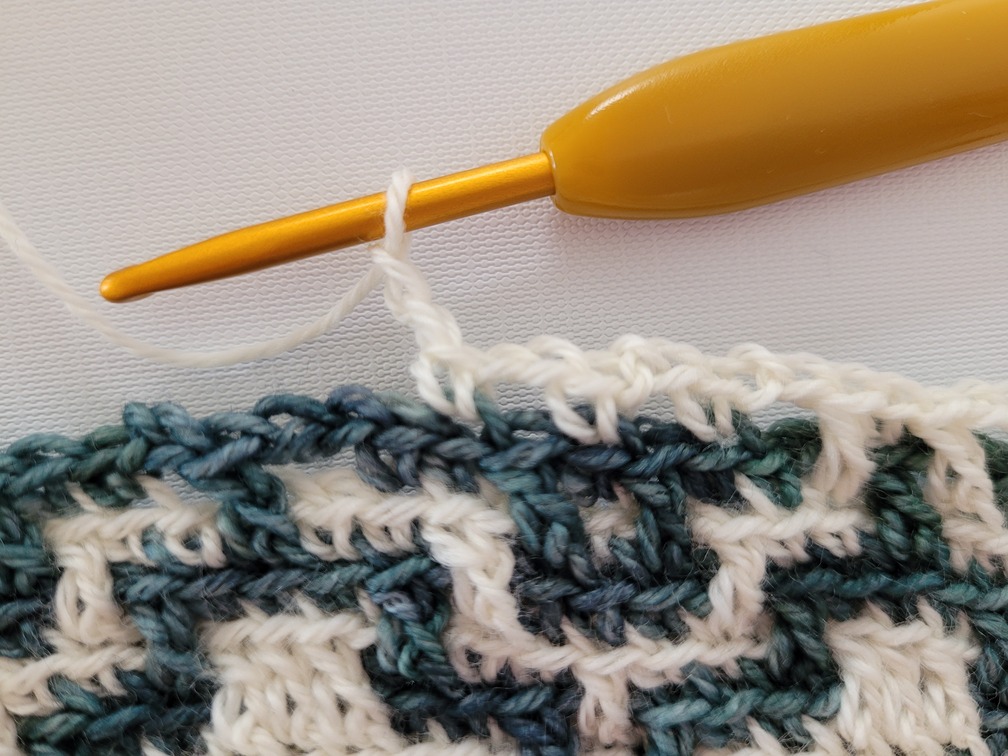
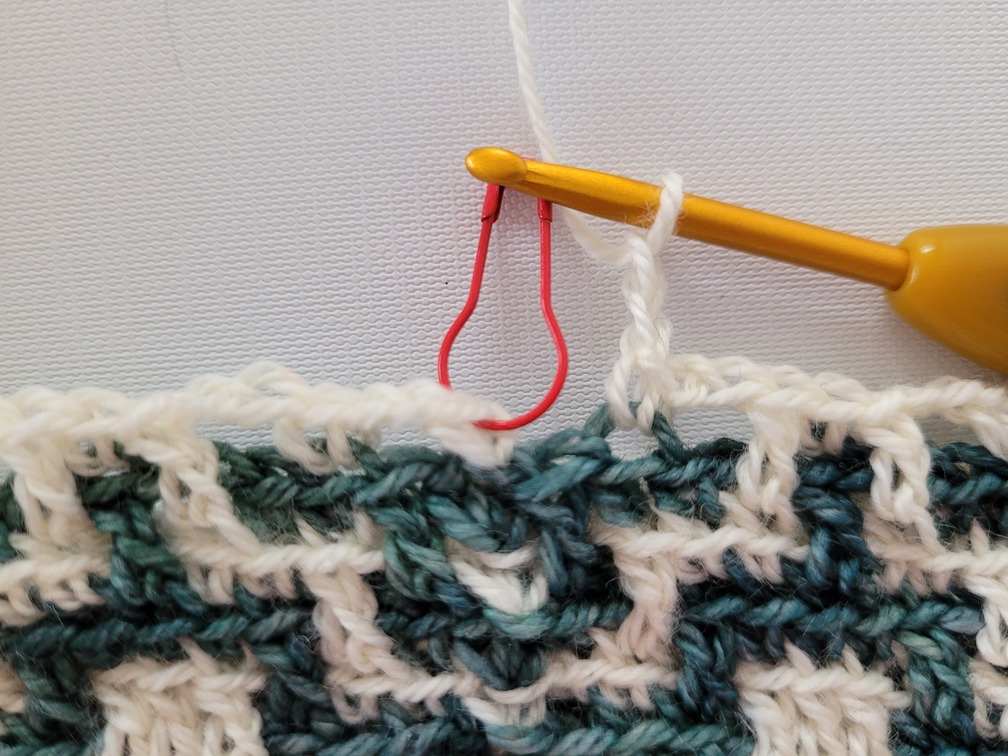
Round 35 (yarn A): ch1, sc1 in BOR (mark this st as a new BOR), BLmosaicdc1, BLsc1, BLmosaicdc1, BLsc3, BLmosaicdc1, BLsc1, BLmosaicdc1, [BLsc1, BLmosaicdc1, BLsc1, BLmosaicdc1, BLsc3, BLmosaicdc1, BLsc1, BLmosaicdc1] rep around until BOR, slst to BOR to join. Change to Yarn B in final st.
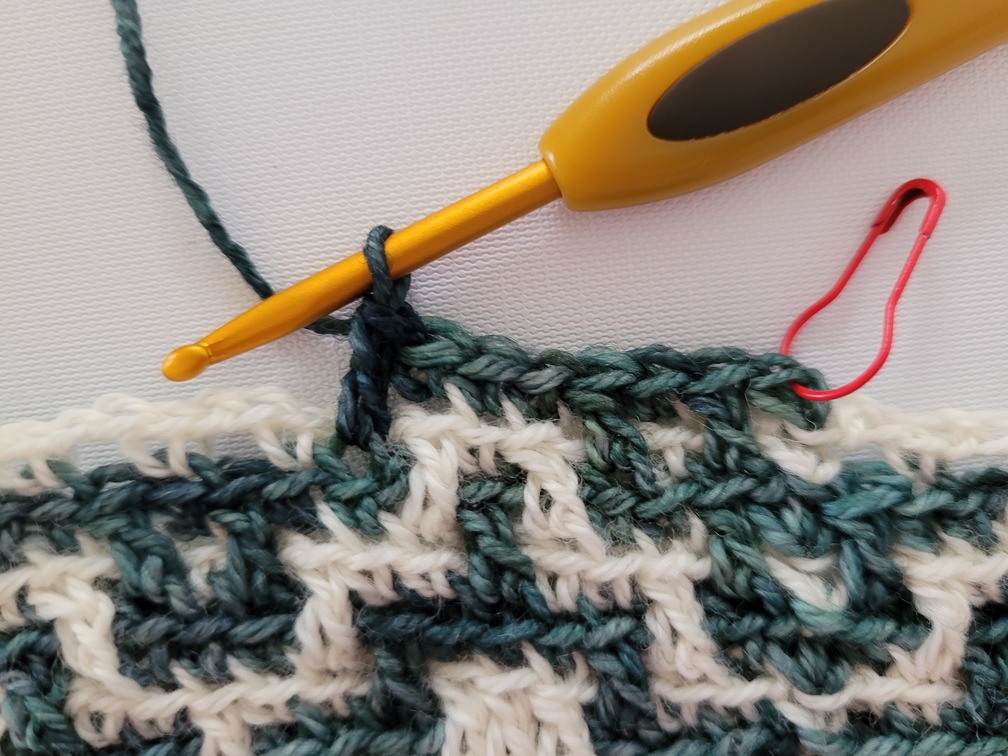
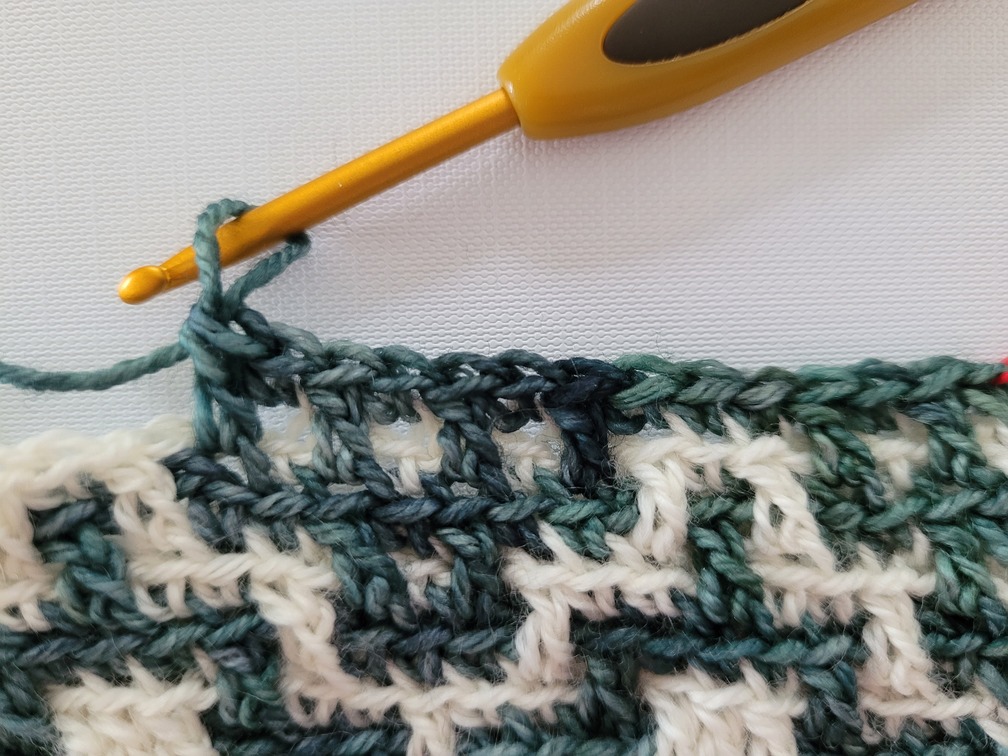
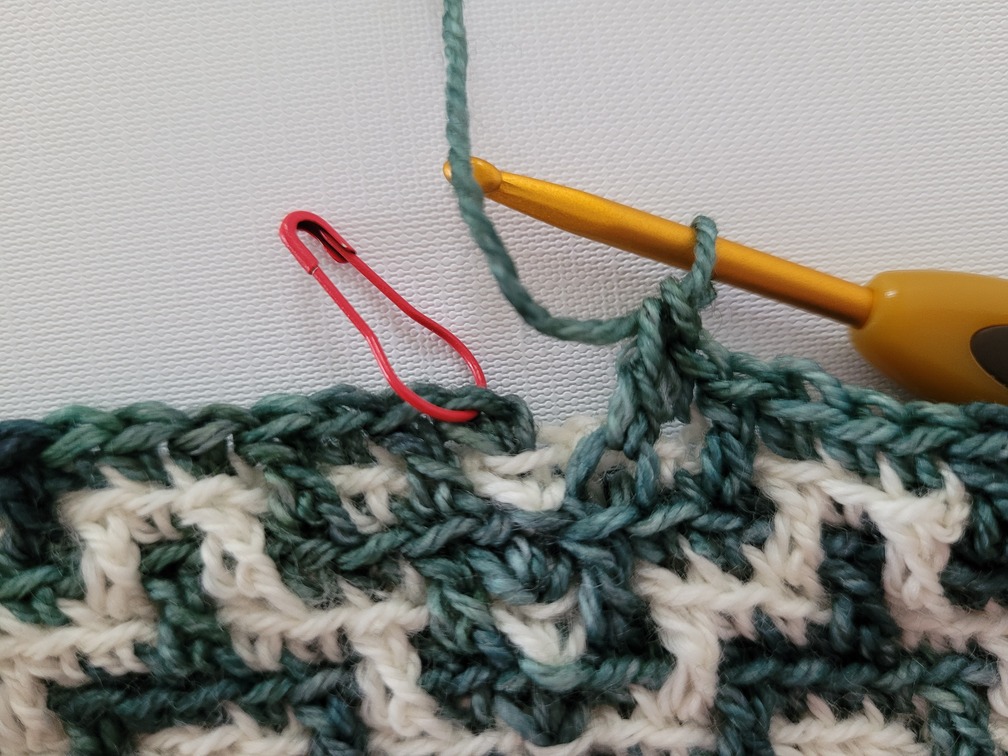
Round 36 (yarn B): ch1, sc1 in BOR (mark this st as a new BOR), ch2, sk 1st, [BLsc1, ch2, sk 1st] rep around until BOR, slst to BOR to join. Change to Yarn A in final st.
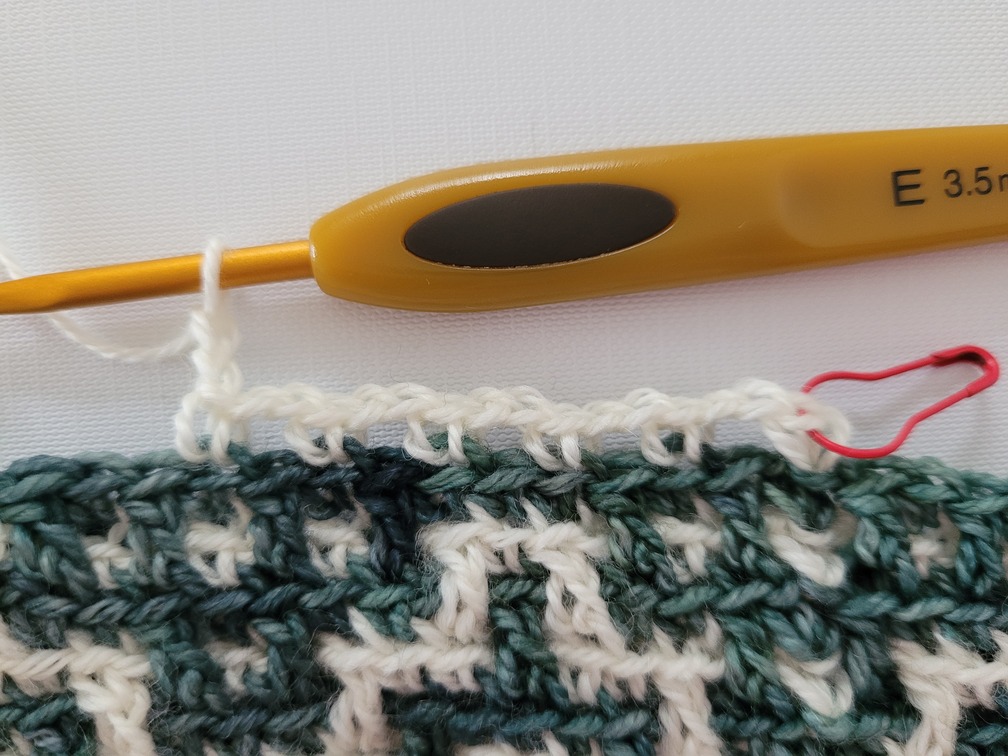
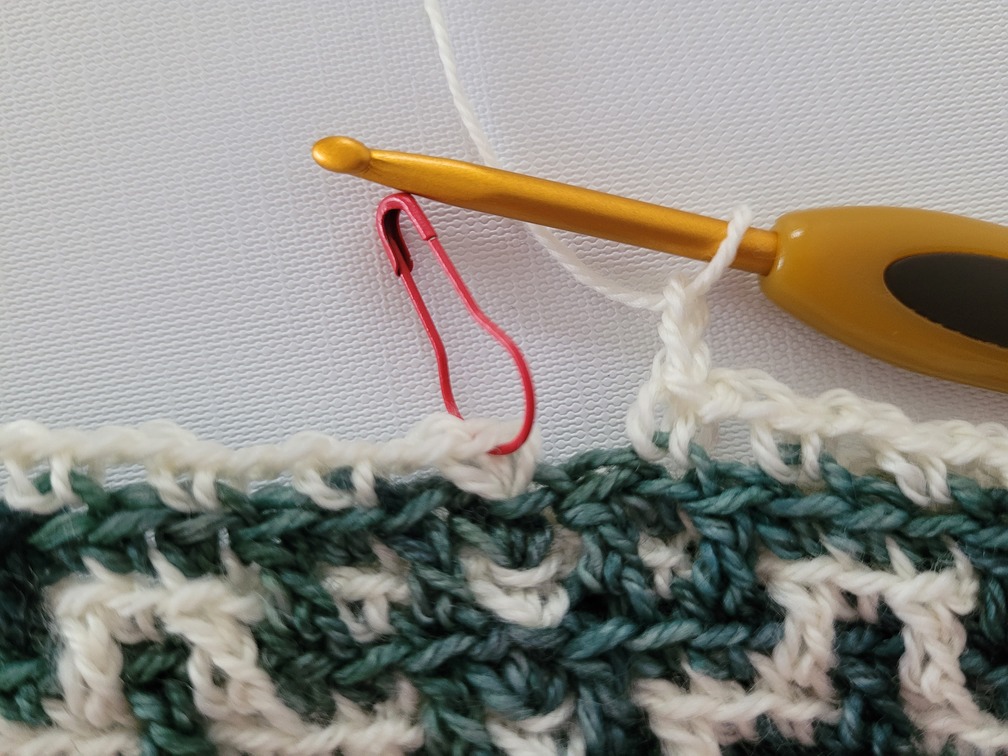
Round 37 (yarn A): ch1, sc1 in BOR (mark this st as a new BOR), BLmosaicdc1, [BLsc1, BLmosaicdc1] rep around until BOR, slst to BOR to join. Change to Yarn B in final st.
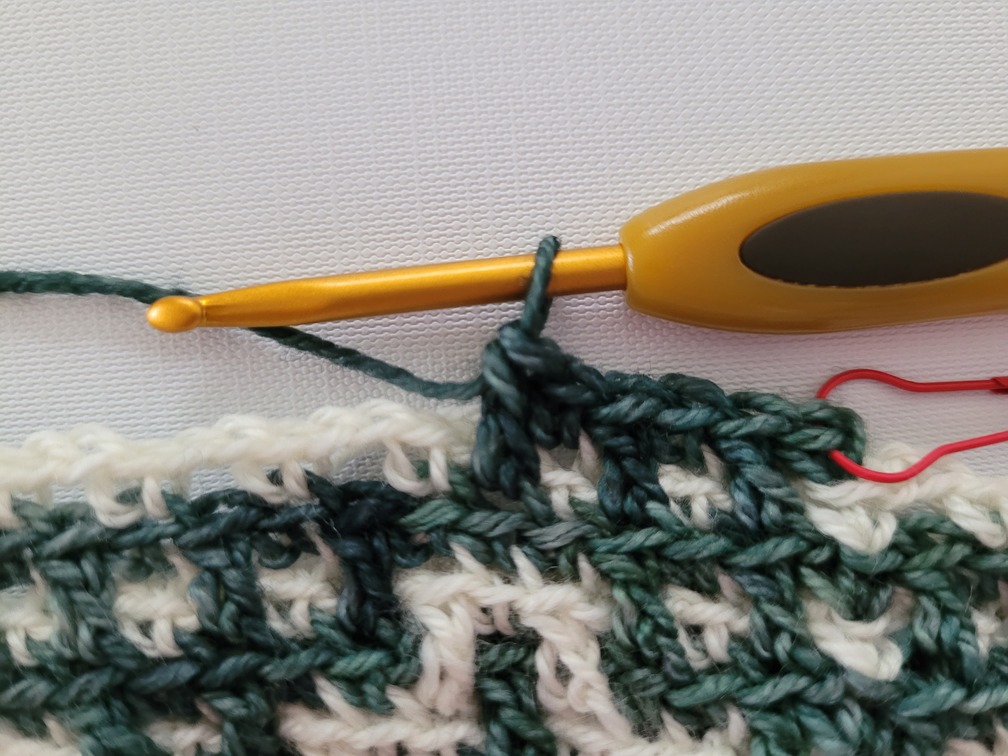
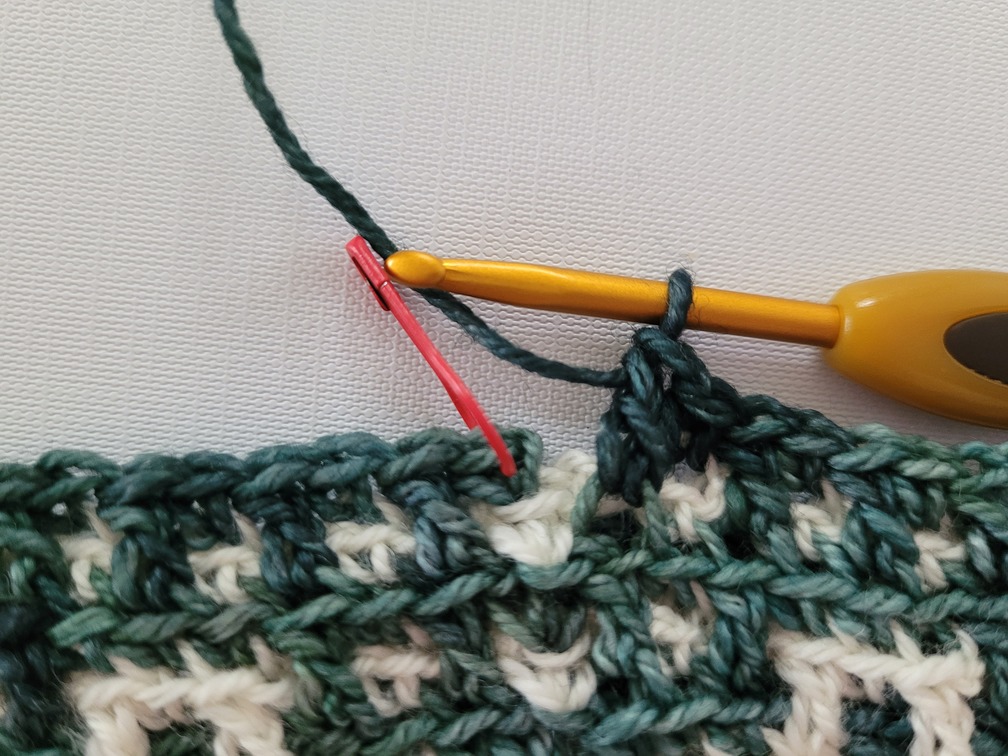
Next, repeat Rows 36 – 37 until row 69 or until desired height.
Don’t break the yarn.
Ribbing 2
This ribbing 2 is worked in rows and attached to the main body as you go. Continue with 3.5mm hook.
Row 1: ch9, starting with 2nd ch from hook, work 1 sc in each ch back to main body. Join to the next st of the main body using slst and work one more slst in the next st of main body (2 slst(s) in total for joining) plus make ch1. Turn.
Row 2: Starting from 4 st from hook, work BLsc in each st across to end. Turn.
Row 3: ch1 (does not count as a st), BLsc in each st across [8sts]. Join to the next st of main body using slst and work one more slst in the next st of main body (2 slst(s) in total for joining) plus make ch1. Turn.
Repeat Rows 2-3 until your ribbing is joined to the entire main body. Then join your last row with the first row using the slip stitches.
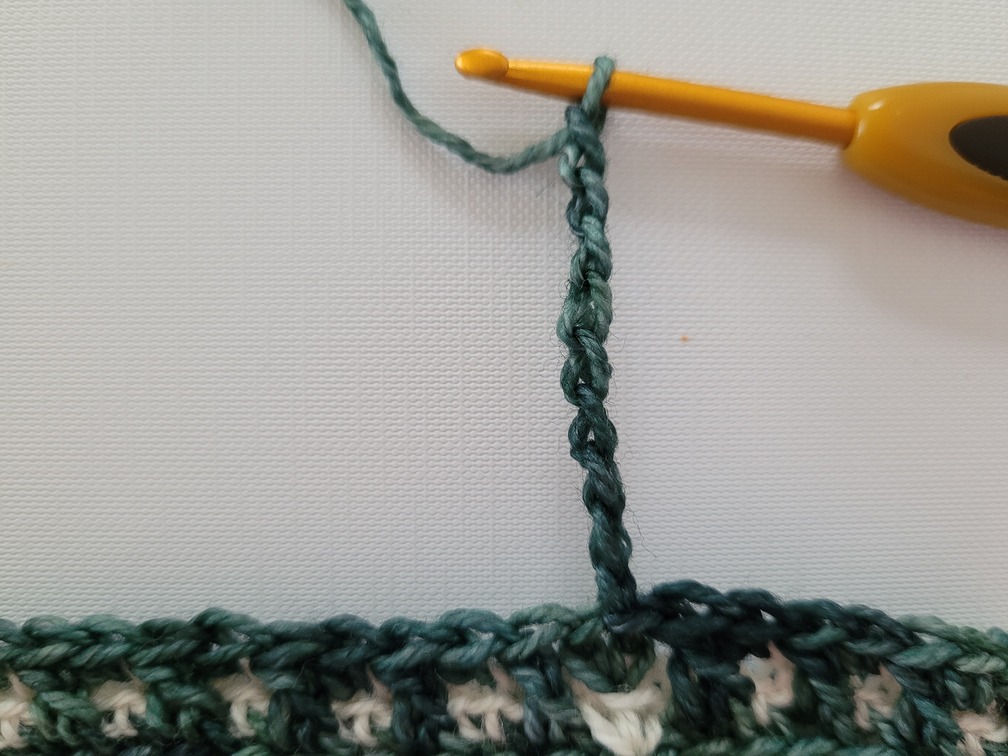
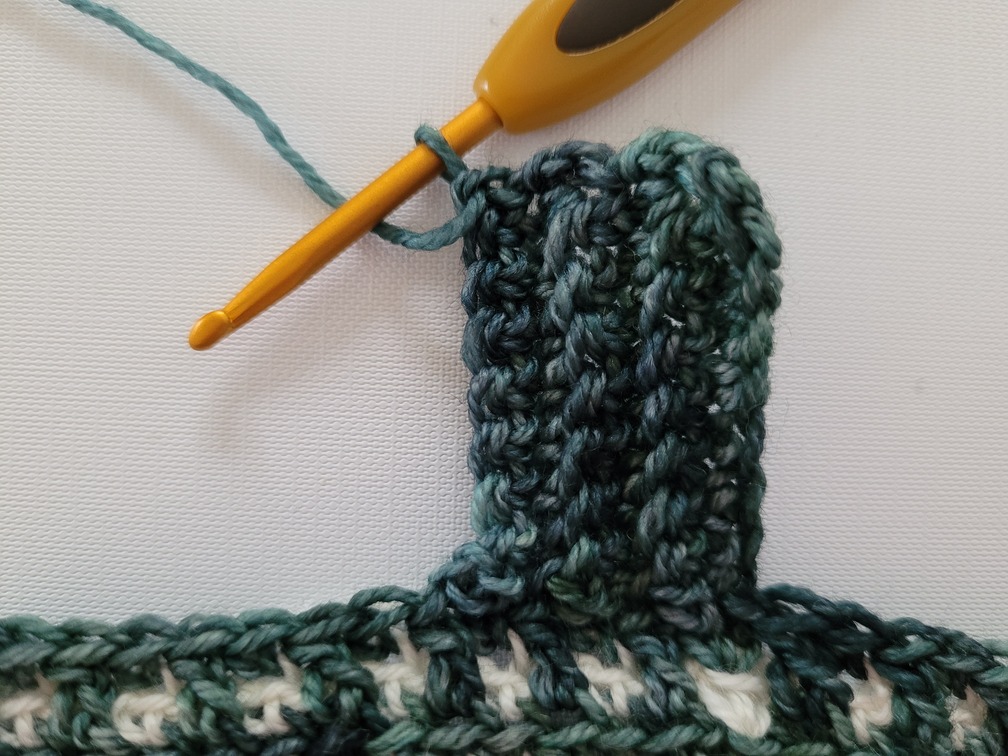
Fasten off yarn, weave in all ends and block your cowl.
If you have any suggestions or have detected any mistakes, please feel free to email me at mycrochetory@gmail.com

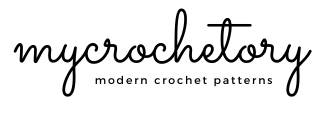


I am not a cowl person, but this cowl is simply beautiful, so there’s every reason to make it as a gift for someone who will agree how beautiful it is. Thank you so much for the pattern and the tutorial photos–they are so clear!
Dear Sylwia, I started this beautiful cowl of yours today and I follow your written instructions. I think I spotted a mistake in round 11. It’s stated: Round 11 (yarn A): ch1, sc1 in BOR (mark this st as a new BOR), BLsc1, ch8, sk 7sts, BLsc1, [BLsc2, ch8, sk 7sts, BLsc1] rep around until BOR, ch4, sk 3sts, slst to BOR to join. Change to Yarn B in final st., but in my work it ended in last repetition scheme (just as shown in your picture) and then directly slst to BOR – without the “ch4, sk 3sts” after last repetition. Greetings, Angelika
Would be BEAUTIFUL also as a sweater!!!